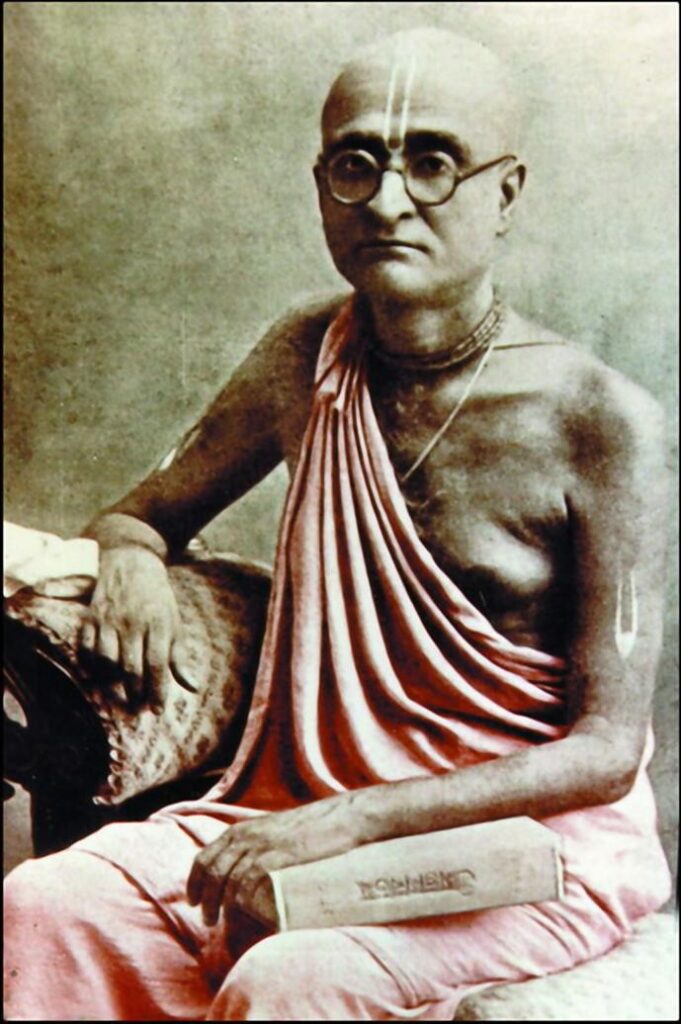
As has been previously described, after the disappearance of Srila Bhaktivinoda Thakur and Srila Gaurakisora Das Babaji Maharaj, Srila Bhaktisiddhanta Sarasvati was grief stricken and was feeling the pangs of separation. He was feeling incapable of carrying on the mission of spreading Lord Chaitanya’s teachings throughout the world, as he had been requested by his father, Srila Bhaktivinoda Thakur, and by his initiating spiritual master, Srila Gaurakishora Das Babaji. Then one night he had a visionary trance in which Lord Chaitanya arrived at the Yogapitha temple with His associates. Amid the sound of sankirtan, Lord Gauranga was ascending to His birth site. With Him were the Six Goswamis. Srila Jagannath Das Babaji, Srila Bhaktivinoda Thakur, and Srila Gaurakisora Das Babaji were also present in their effulgent transcendental forms.
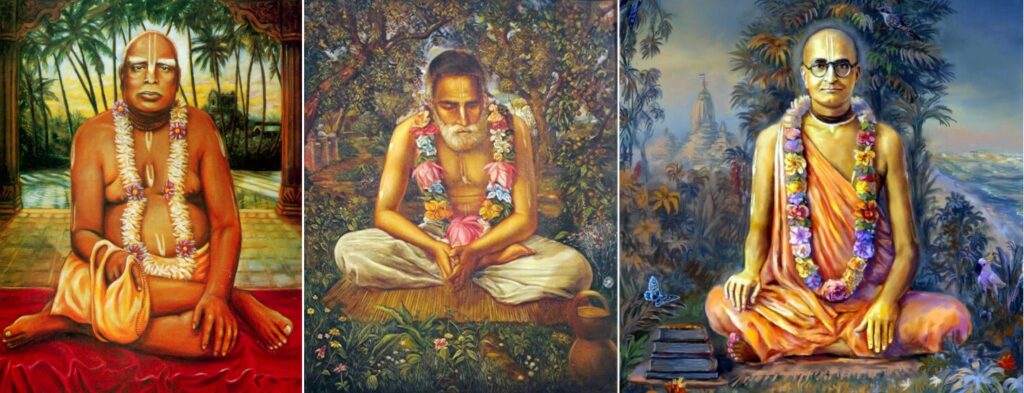
Addressing Srila Bhaktisiddhanta Sarasvati directly, they said:
Why are you in such a state of anxiety? Begin your task of establishing pure religion. Everywhere preach the message of Sri Gaura and spread the service of the Holy Name, abode, and desire of Sri Gaura. We are always ready to help you, being eternally present with you. In your mission of establishing pure devotional service, you will always receive our help. Behind you innumerable people, unlimited wealth, and extraordinary scholarship are waiting to help you. Whatever you need at any time will immediately appear to serve your mission of pure devotion. With full enthusiasm, proceed with your preaching of the message of pure devotion as it was preached by Sriman Mahaprabhu. No material problems can impede you. We are always with you.
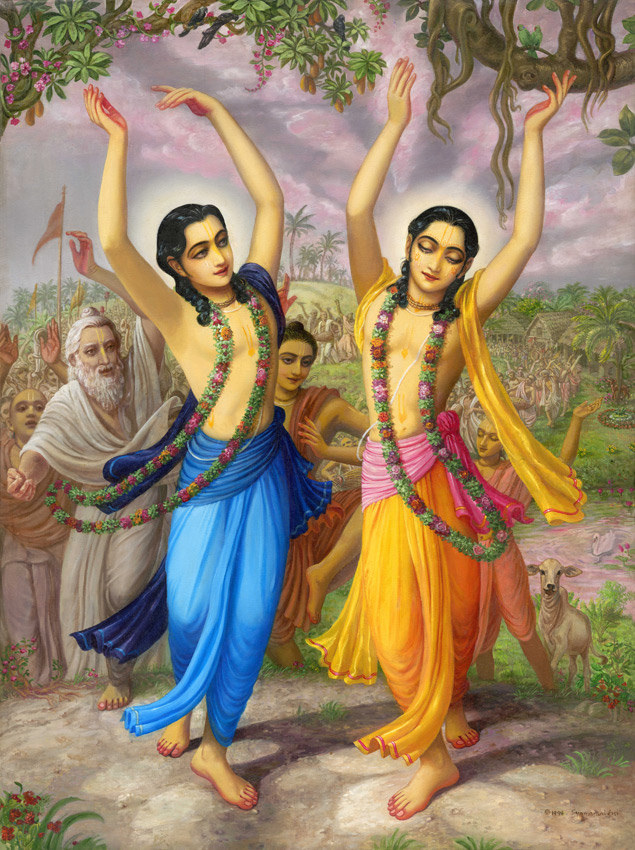
With this spectacular vision in mind as his impetus, Srila Bhaktisiddhanta Sarasvati Thakur thought the time had come for widespread preaching. Up until 1918 Siddhanta Sarasvati was mainly immersed in chanting and publishing books. In Vrajapattana, Mayapur, on the 29th of March, 1918, Siddhanta Sarasvati took sannyas and took the name Sri Bhaktisiddhanta Sarasvati Gosvami Maharaja at the age of 44, according to the Vedic rites which he had gathered from members of the Ramanuja sampradaya in his travels.
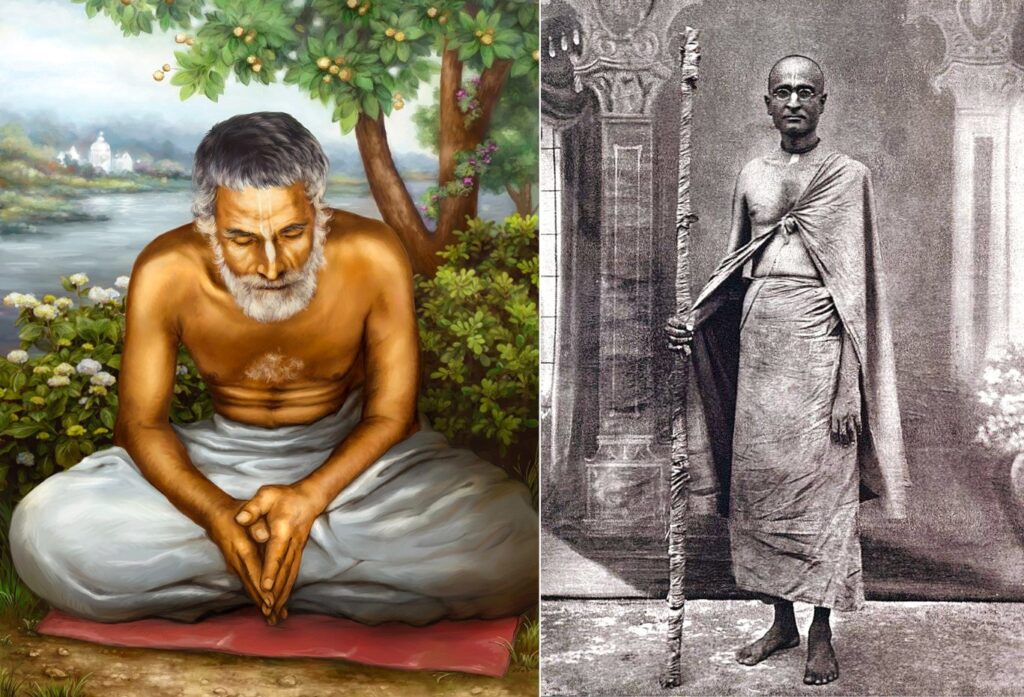
He took sannyas initiation from a picture of Srila Gaurakisora Das Babaji Maharaja. Taking sannyas from a picture was certainly not a standard practice of the Ramanujas, or Vaisnavas in general. The situation, however, was unique. Srila Sarasvati Thakur had no spiritual master who was physically present, and he had no godbrothers, being the only disciple of Gaurakisora Das Babaji. He was furthermore a self-realized soul, and there is no doubt that he took sannyas to fulfill the innermost desires of his spiritual masters, who had both ordered him to preach. This practice was never meant to be imitated by others in much less unique and less qualified positions.
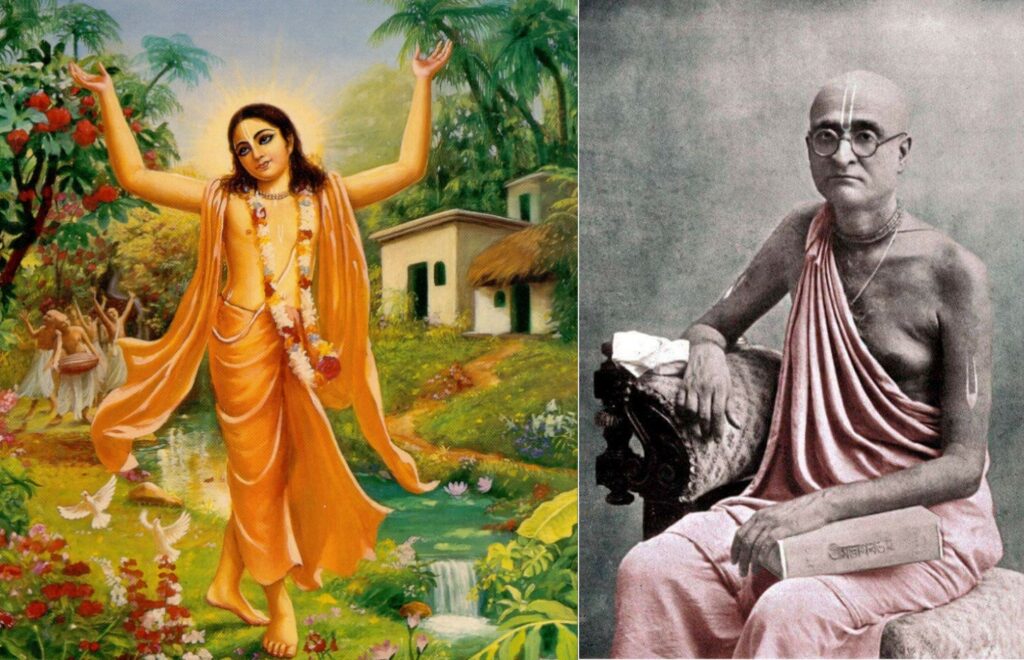
Traditionally, the followers of Sri Chaitanya Mahaprabhu, beginning with the Gosvamis of Vrindavan, had largely accepted the babaji-vesa (dress), making their main business the chanting of the Holy Name in the mood of a solitary bhajananandi. This had largely been the convention since the time of Sri Chaitanya Mahaprabhu. However, as his mission required that he engage more in outgoing preaching work rather than solitary worship, Srila Bhaktisiddhanta Sarasvati felt that the order of sannyas was more appropriate for spreading Lord Chaitanya’s mission. With a view to exhibit the activities of a gosthy-anandi, a preacher, he accepted the dress of a sannyasi.
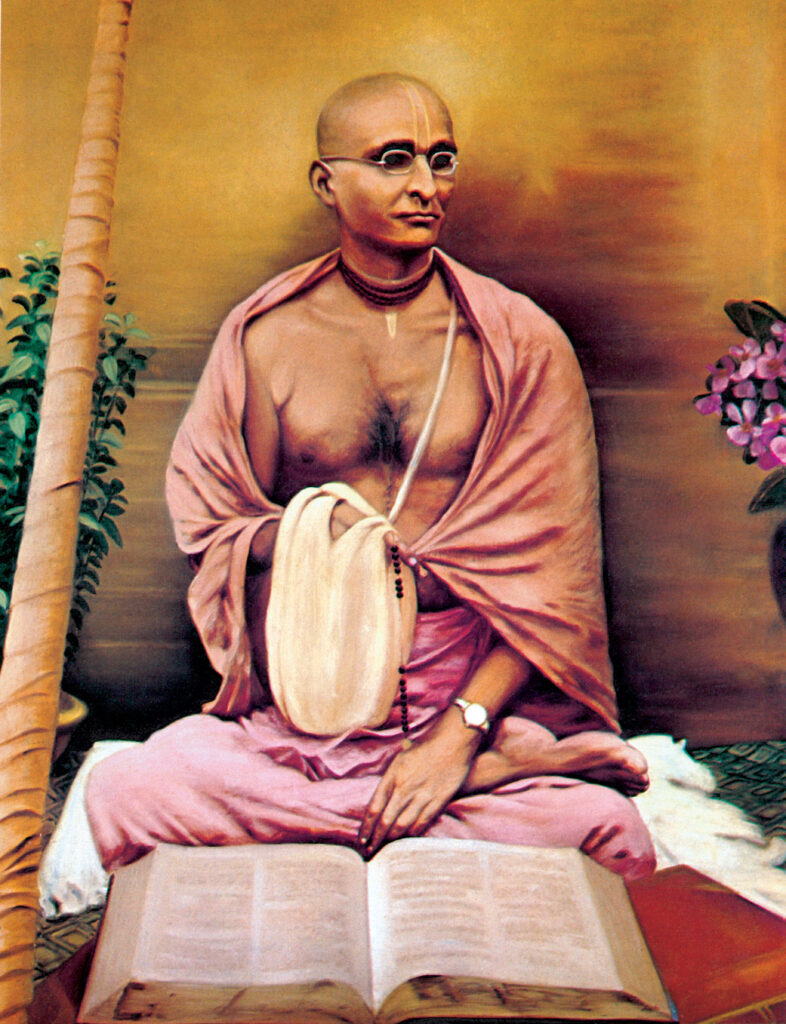
Also, at that time many phony renunciates and bogus sahajiyas who secretly lived a sinful life, were wearing babaji dress. Out of extreme humility and respect, Bhaktisiddhanta Sarasvati Thakur wanted to exhibit by his personal example, just how exalted such personalities should be if they want to wear the same dress as Srila Rupa Gosvami, Srila Bhaktivinoda Thakur, Srila Gaurakisora Das Babaji Maharaj, and other exalted eternal associates of the Lord. For his preaching work, Srila Sarasvati Thakur chose to accept sannyas, as people in India at that time naturally showed respect to sannyasis, and this was Sri Chaitanya Mahaprabhu’s motive for taking sannyas as well: to save and attract persons, some of whom would have otherwise criticized Him or not taken Him seriously.
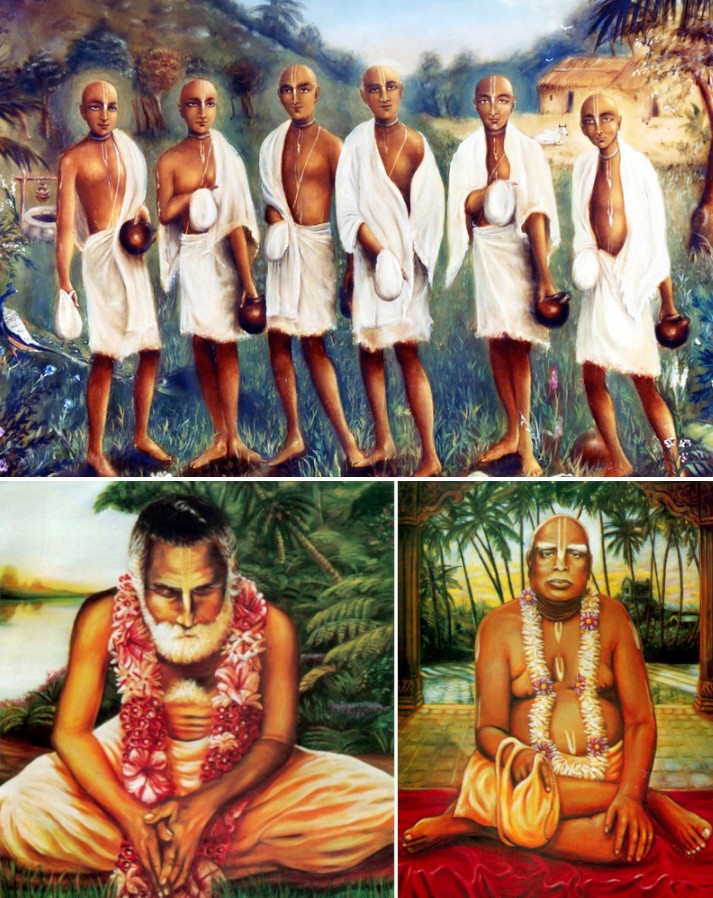
The characteristics of a Gosvami are described by Srila Rupa Gosvami in the first verse of Sri Upadesamrta (The Nectar of Instruction):
A sober person who can tolerate the urge to speak, the mind’s demands, the actions of anger and the urges of the tongue, belly and genitals is qualified to make disciples all over the world.
Srila Bhaktisiddhanta Sarasvati Thakur wanted to establish a mission that would take the teachings of Sri Chaitanya Mahaprabhu all over the world. He was beginning his preaching effort towards the end of the First World War, in which many Indian nationalists had taken part on the side of the British, thinking that this might encourage the British to consider their desires for independence. This was not to be. In 1919 the British passed the Rowlatt Act to repress the move for Indian freedom, and one week later in Amritsar in the square called Jallianwalla Bagh, British soldiers shot and killed hundreds of unarmed, peaceful Indian protestors.
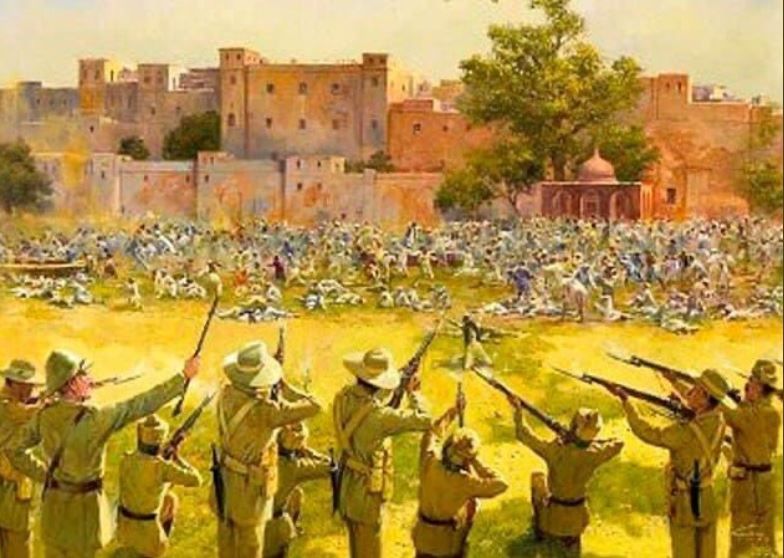
Gandhi’s non-cooperation movement gained momentum and nationalistic fervour was at its height. It was in the atmosphere of British rule and nationalistic foment, a time of revolution, that Srila Bhaktisiddhanta Sarasvati Thakur began his preaching. But as Srila Bhaktivedanta Swami Prabhupada learned in his meeting with this great saintly person in 1922, it was not a nationalistic revolution that Srila Bhaktisiddhanta Sarasvati Thakur was interested in igniting, but rather the spiritual lives of humanity at large.
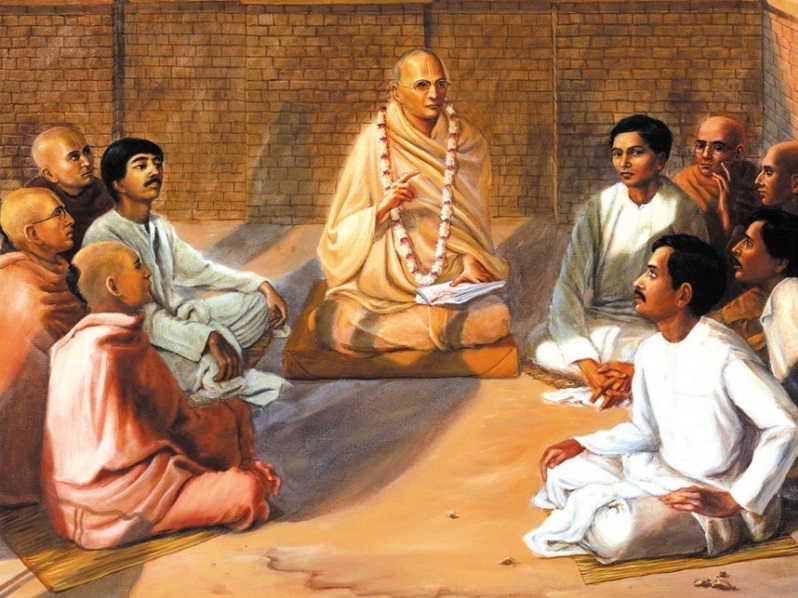
The purifying power of transcendental literature is described in the Srimad-Bhagavatam:
On the other hand, that literature which is full of descriptions of the transcendental glories of the name, fame, forms, pastimes, etc., of the unlimited Supreme Lord is a different creation, full of transcendental words directed toward bringing about a revolution in the impious lives of this world’s misdirected civilization. Such transcendental literatures, even though imperfectly composed, are heard, sung and accepted by purified men who are thoroughly honest.
[Srimad Bhagavatam 1:5:11]
Bhaktisiddhanta Sarasvati Thakur wanted to effect the upliftment of mankind throughout the world to the eternal, spiritual platform of Krishna consciousness, where all strife, sectarianism, social discord, etc., were resolved forever. The means were the teachings of the liberated sages in the form of transcendental books. He aimed to propagate the great science of self-realization far and wide.
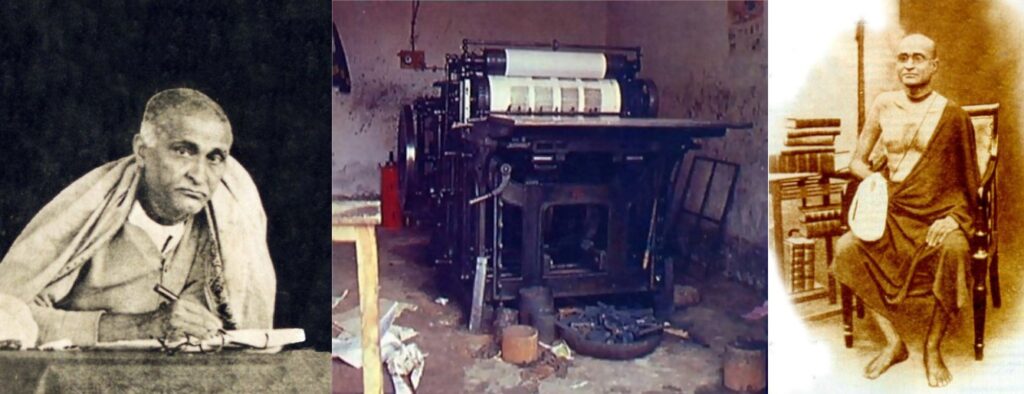
Sarasvati Thakur, on the same day as he accepted sannyas, established a temple at Vrajapattana called the Chaitanya Math, and installed the Deities Sri Sri Guru Gauranga and Sri Sri Radha Govinda. This Sri Chaitanya Math in Mayapur is the Akar Math – the original or parent math (or temple) – of all the Gaudiya Maths all over the world. In the afternoon he delivered a lecture about the appearance of Sriman Mahaprabhu to the assembled crowd. The next day he initiated a number of devotees.
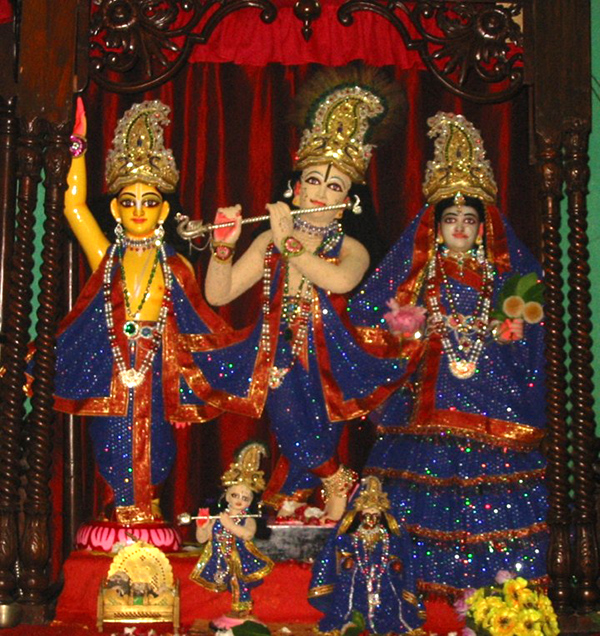
Deities Sri Sri Guru Gauranga and Sri Sri Radha Govinda
He began to preach in the immediate locality in Krishnanagar, Dalautpur, etc. In June he left Calcutta with a group of 23 devotees for Jagannath Puri, and he visited Sauri, Kumara, etc. on the way and saw the Gopinath Deity at Remuna. At Balasore he lectured on the Siksastaka, Lord Chaitanya’s eight prayers of instruction, and he also gave discourses in Cuttack and Puri.
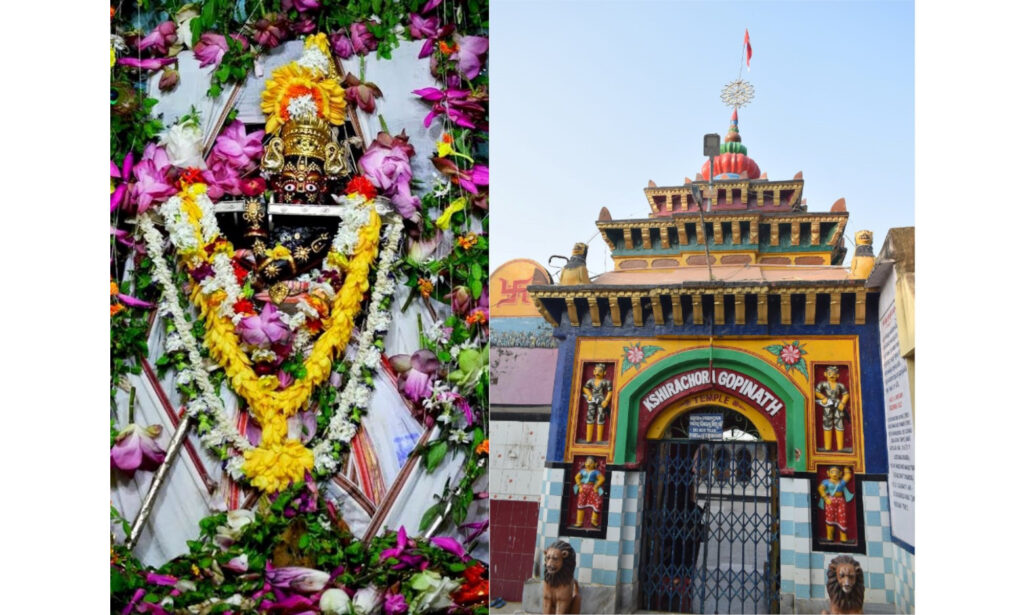
Gopinath Deity at Remuna
While in a forested area in Alalanath, near Jagannath Puri, Srila Sarasvati Thakur entered a state of deep ecstasy and trance. Having realized the non-difference of this forest and the forest of Vrindavan, he lost his external awareness of the world. When he came back to his external consciousness alone in the woods, he could not determine where he was. Meanwhile, his followers, who had originally assumed that he had gone to the forest to answer the call of nature, became very worried about him and began to search for him everywhere. Finally, they found him and led him out.
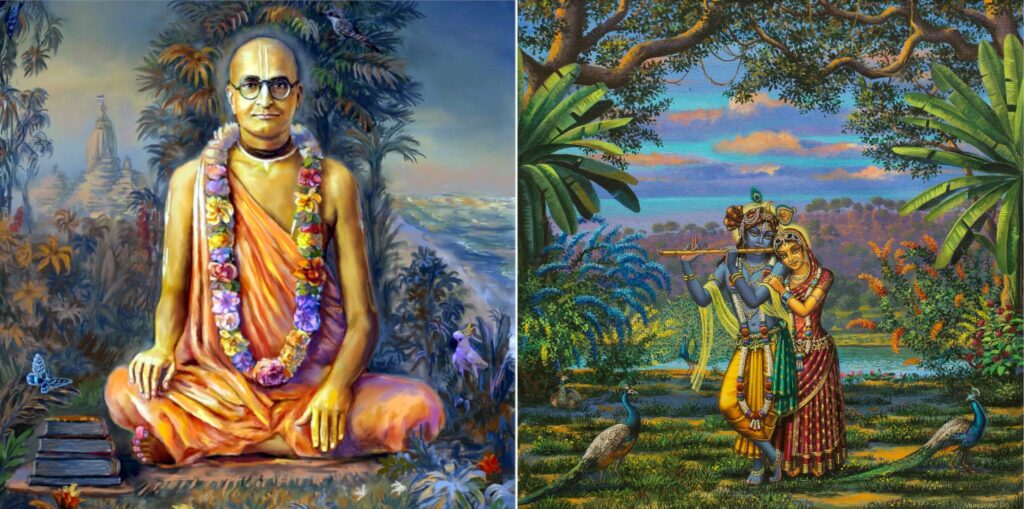
As he travelled to the various sites of Sri Chaitanya Mahaprabhu’s pastimes, Srila Sarasvati Thakur was overwhelmed on several occasions with symptoms of ecstasy and would always cite and chant the appropriate verses from Chaitanya-caritamrta to glorify the mood and activities of the Lord in those sites.
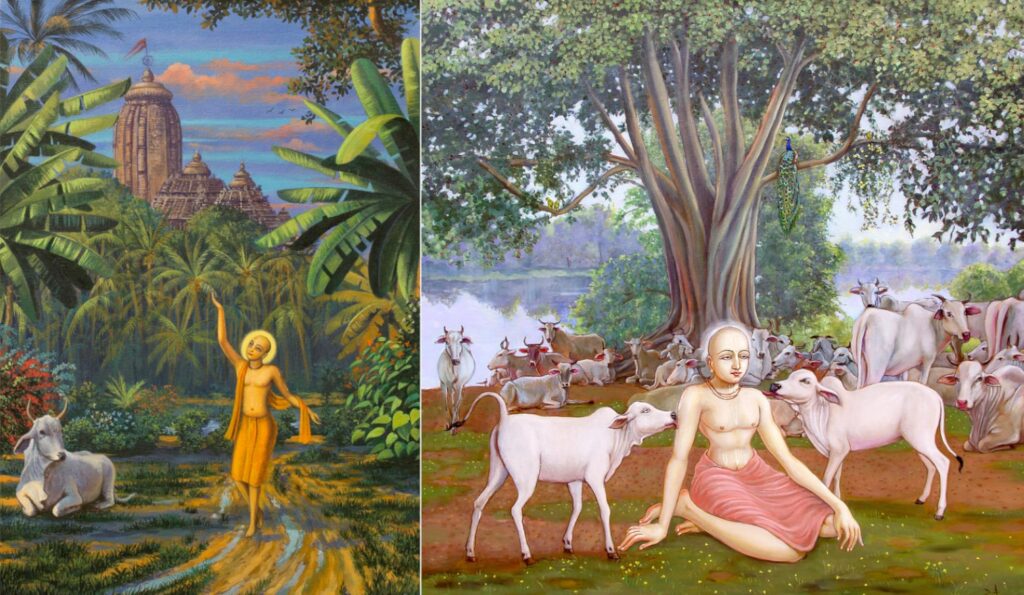
During this tour, when Srila Sarasvati Thakur and his followers were returning from a darsan of the Saksi-Gopala Deity, he noticed that his householder followers refused to give alms to some poor people who were requesting help. He then sarcastically described their attitude, saying:
Money should not be given to poor, distressed people … if it is given it will be karma-kanda.
Srila Sarasvati Thakur was in this instance satirizing the attitude of his disciples, who were thinking that it was beneath them, as transcendental Vaisnavas, to give charity to the poor, as though this were a continuing activity within the realm of karmic activity – a material activity which would bind them to the law of karma.
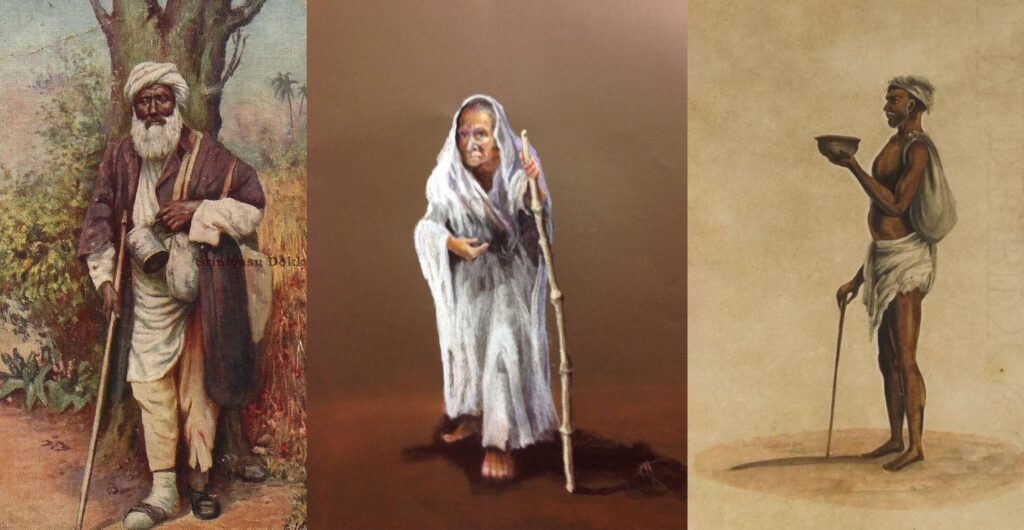
He further stated that:
This type of consideration by householders expresses miserliness, mercilessness, and a lack of affliction at others’ distress. From this attitude the heart becomes hard and attacked with niggardliness, and as a result the tendency to spend money even for Vishnu’s service, which is the means of one’s own interest, disappears. Therefore, offense in service (seva-aparadha) is invited. In order to guard against all these hypocritical, sinful deliberations, Sri Gaurasundara in His pastimes used to give help to lowly, distressed people. Even earned wealth is obtained by the mercy of God. It is not the incorrect use of wealth if some portion of mercy is given to requesting poor people – it is its proper use! To distribute mercy (prasada) is the compulsory duty of householder Vaisnavas. Even though their (poor people’s) miserableness has been obtained through the fault of their own karma … they are still God’s people. Therefore, to give them help is the compulsory duty of well-to-do people. However, to think of them as *“Narayana” is only blindness to truth and a terrible spiritual offense!
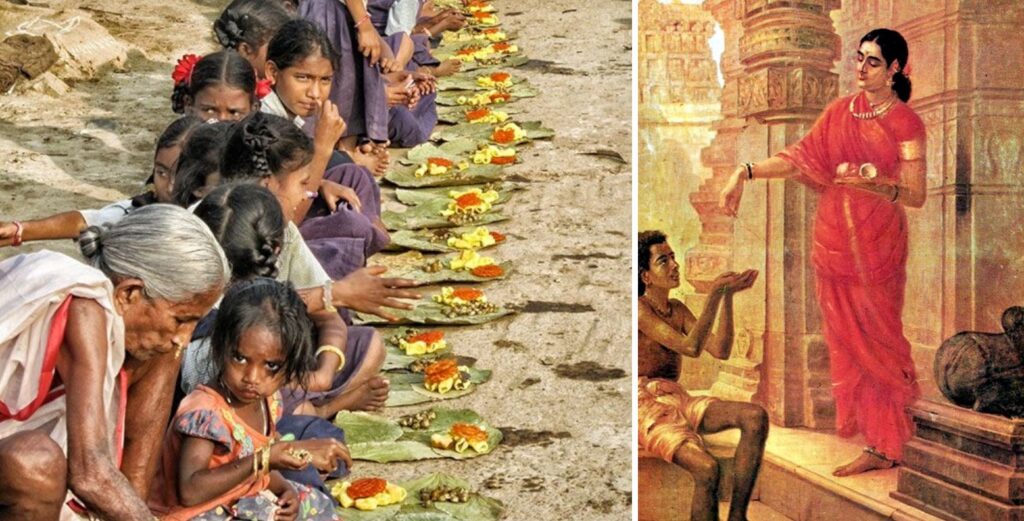
*Here, Srila Bhaktisiddhanta is referring to the term “daridra-narayana” meaning “poor Narayana.” This was a term coined by the nineteenth century impersonalist teacher Vivekenanda. Seeing everyone as being God, he taught that the highest way to serve God was by looking after the material needs of the poor. Vivekananda said:
The only God that exists, the only God in whom we believe … my God the miserable, my God the poor of all races.
This term “daridra-narayana” was later taken up by a famous Indian politician.
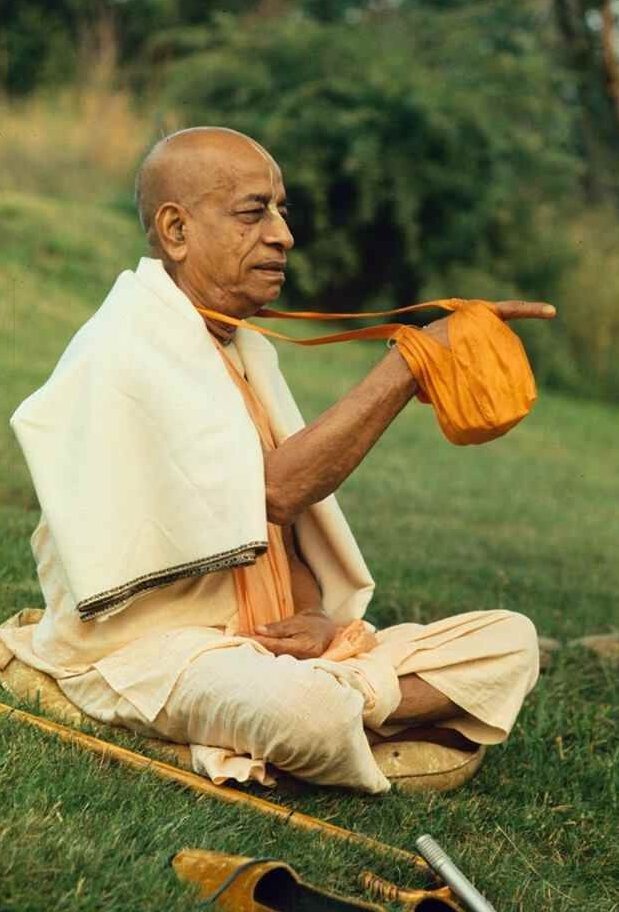
Srila Bhaktivedanta Swami refuted the idea that a person in poverty is God experiencing hardship, or “poor Narayana”:
… Unscrupulous men sometimes address a poor man as daridra-narayana, or “poor Narayaṇa.” This is most unscientific. Lord Vishnu and Laksmi are always situated in everyone’s heart, but this does not mean that everyone is Narayana, especially not those in poverty. This is a most abominable term to use in connection with Narayana. Narayana never becomes poor, and therefore He can never be called daridra-narayana. Narayana is certainly situated in everyone’s heart, but He is neither poor nor rich. Only unscrupulous persons who do not know the opulence of Narayana try to afflict Him with poverty.
[Srila Bhaktivedanta Swami: Purport to Srimad Bhagavatam 6:19:9]
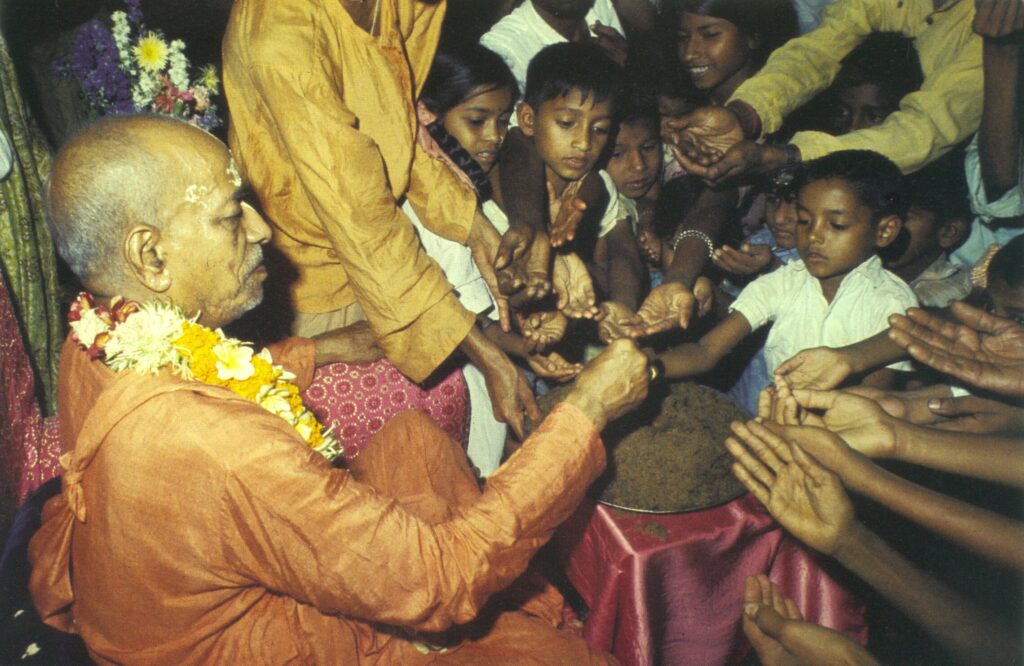
It is recommended that everyone distribute prasada, considering every living being a part and parcel of the Supreme Lord. Even in feeding the poor, one should distribute prasada. In Kali Yuga, there is a scarcity of food almost every year, and thus philanthropists spend lavishly to feed the poor. For this they invent the term daridra-narayana-seva [service to poor Narayan]. This is prohibited. One should distribute sumptuous prasada, considering everyone a part of the Supreme Lord, but one should not juggle words to make a poor man Narayana. Everyone is related to the Supreme Lord, but one should not mistakenly think that because one is related to the Supreme Personality of Godhead, he has become the Supreme Personality of Godhead, Narayana. Such a Mayavada philosophy is extremely dangerous.
[Srila Bhaktivedanta Swami: Purport to Srimad Bhagavatam 7:15:6]

No. 1 Ultadanga Junction Road
In November of 1918 a house was rented at No. 1 Ultadanga Junction Road in Kolkata [Calcutta], and Srila Sarasvati Thakur established the Sri Bhaktivinoda Asana there. Although there was no arrangement for rent, some of the householder disciples of Srila Bhaktisiddhanta Sarasvati Thakur took up the responsibility for maintaining the preaching effort. In this building the Gaudiya Math was first established in 1918 by Srila Bhaktisiddhanta Saraswati Goswami Thakur and his preaching expanded worldwide from this place. This building served as the headquarters of the Gaudiya Math for 12 years from 1918-1930. It was here that Abbhay Charan De, who was later to become Srila Bhaktivedanta Swami, first heard Srila Bhaktisiddhanta Sarasvati speak, in 1922.
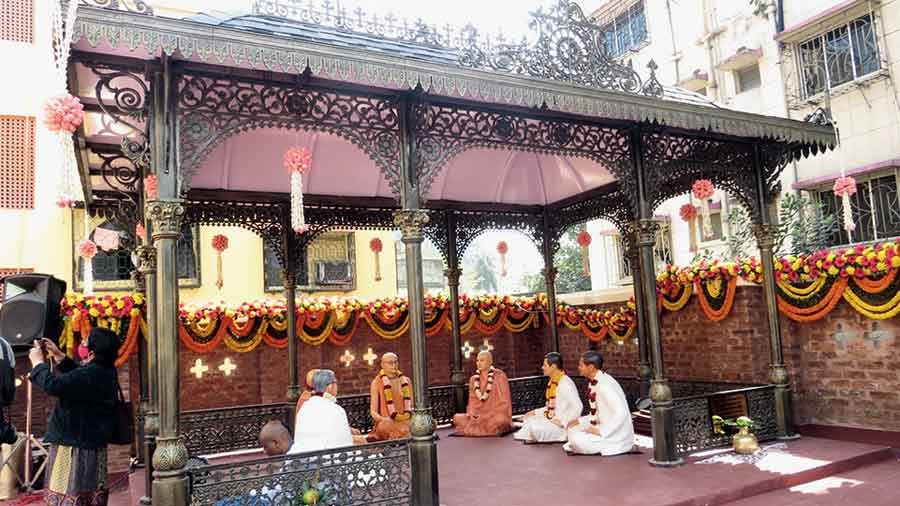
Courtyard where Srila Bhaktivedanta Swami first heard Bhaktisiddhanta Sarasvati speak

In December of 1918 Srila Sarasvati Thakur set out with ten devotees on a preaching tour. His first stop was in Yasohara, and an engagement was held in the house of a famous lawyer named Raya Bahadur. Discourses were held in his house which culminated in a Vaisnava conference chaired by Srila Sarasvati Thakur. During the conference he gave an ecstatic lecture about Srila Haridas Thakur, who had been born in a Muslim family at Butana Pargana in the Yasohara District. At the end of the lecture he concluded:
He who worships is great. Non-devotees are of no consequence. There is no consideration of caste, family, etc. in the worship of Krishna.
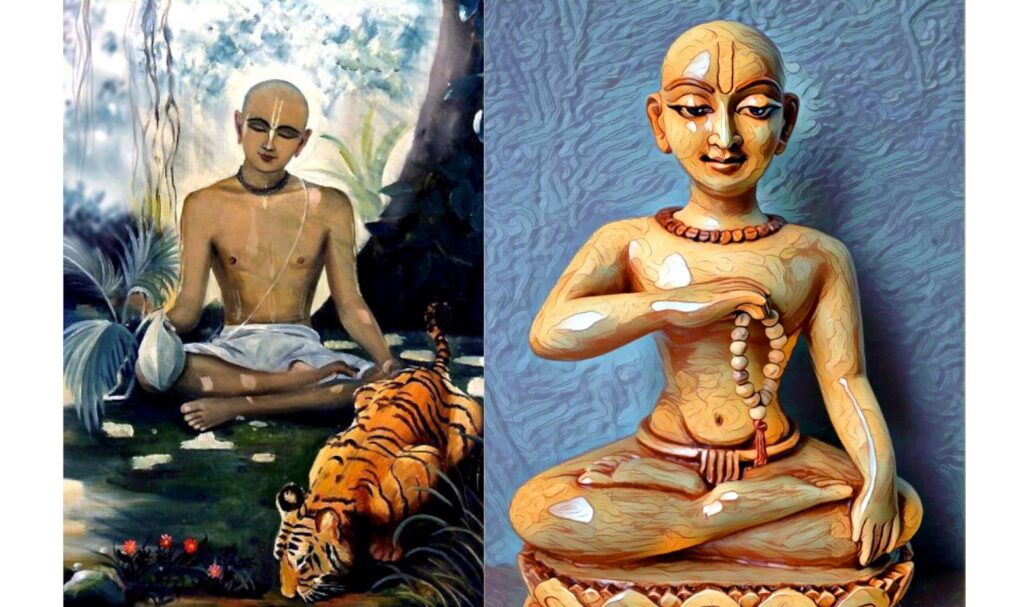
Haridas Thakur
This was followed by powerful sankirtan in the city of Yasohara. From there the preachers proceeded to the Khulna District, and in the house of Nepalchandra Mahasaya they held a big meeting, and devotees from all the neighbouring villages attended. At this time there were some arguments offered about Vedic varnasrama-dharma and devotional behaviour. By explaining verses from the Srimad-Bhagavatam and the Satvata-smrti as proof, Srila Sarasvati Thakur defeated those arguments, explaining the glories of Daivi-varnasrama when determined by one’s personal qualities – rather than his birth – and one’s devotional activities. Haridas Thakur’s position was a perfect illustration of how a great Vaisnava sits above caste considerations. Haridas was born in a Muslim family, but was so adored by Lord Chaitanya that he was made the Namacharya – the foremost teacher of the holy names.
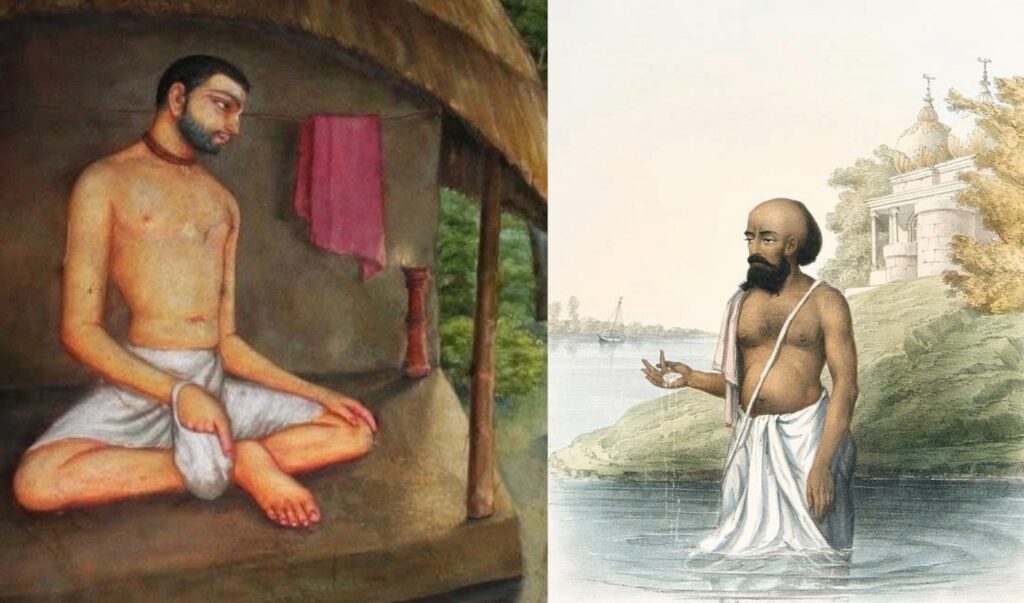
Haridas was rejected and persecuted by many caste brahmans
Daivi-varnasrama is the transcendental system of four social orders and four spiritual orders, as opposed to the caste system determined by one’s birth. In daivi-varnasrama, there cannot be acknowledgement of social status according to birthright, because in Bhagavad-gita it is said that the determining considerations are guna and karma, one’s qualities and one’s work. The Thakur’s teachings on this matter upset many caste brahmans who felt their superior position and power within the social order was being undermined. Even though there were persons in that village who were very offensive in their attitude and behaviour, Srila Sarasvati Thakur personally went door-to-door with his followers in the mood of Lord Nityananda in His dealing with Jagai and Madhai, being very compassionate towards their unfortunate state.
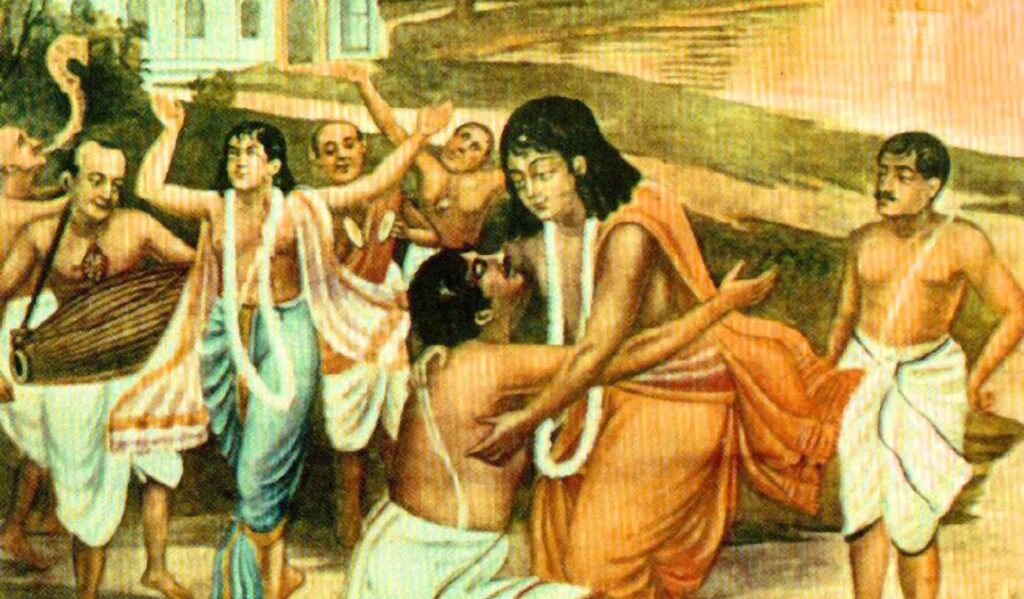
Lord Nityananda begged Lord Chaitanya to forgive Jagai and Madhai after they assaulted Him
On the 1st of January, the sankirtan party performed sankirtan in the city of Banagrama, before returning to the Sri Bhaktivinoda Asana in Calcutta. On the 5th of February, 1919, the Appearance Day of Sri Vishnupriya – the second wife of Lord Chaitanya – was celebrated. At this time, Srila Bhaktisiddhanta Sarasvati Thakur re-established the Sri Visva-Vaisnava-raja-sabha and gave a talk on the history of the sabha, which was later to be known as the Gaudiya Mission. The word “sabha” means “assembly, association or society.”
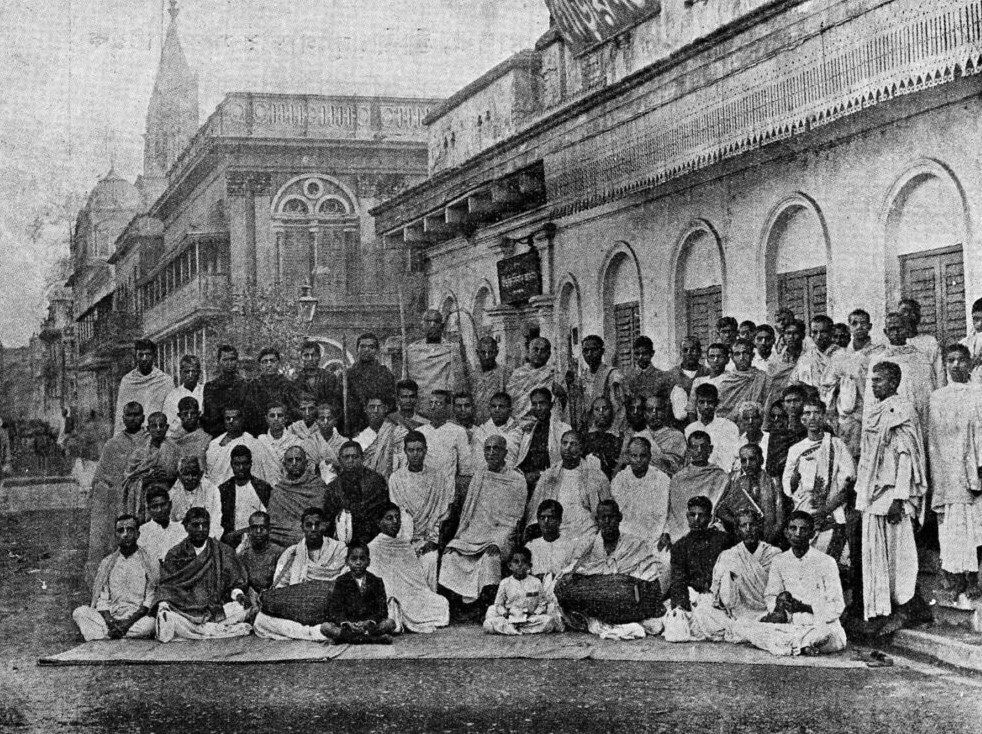
Sri Visva-Vaisnava-raja-sabha outside Bhaktivinoda Asana at Ultadanga Junction Road
Srila Bhaktisiddhanta Sarasvati explained that Srila Jiva Goswami described the Visva-Vaisnava-raja-sabha as the society which is composed of those Vaisnavas who are the kings (the foremost) of all the Vaisnavas present in this world. These foremost Vaisnavas are the followers of the feet of Sri Krishna Chaitanya Mahaprabhu, Who is the saviour of Kali-yuga, the Bestower of His own method of worship, and Who is the incarnation of Krishna-prema (pure love for Krishna), even though He is Sri Krishna Himself, the Embodiment of Krishna-prema. The objects of respect for this Sri Visva Vaisnava-raja-sabha are Srila Rupa Gosvami and Srila Sanatan Gosvami, who are the associates of Chaitanya Mahaprabhu. Their teachings are the Bhagavata-dharma. These teachings constitute the *Bhagavat-sandarbhas or the Sat-sandarbhas.
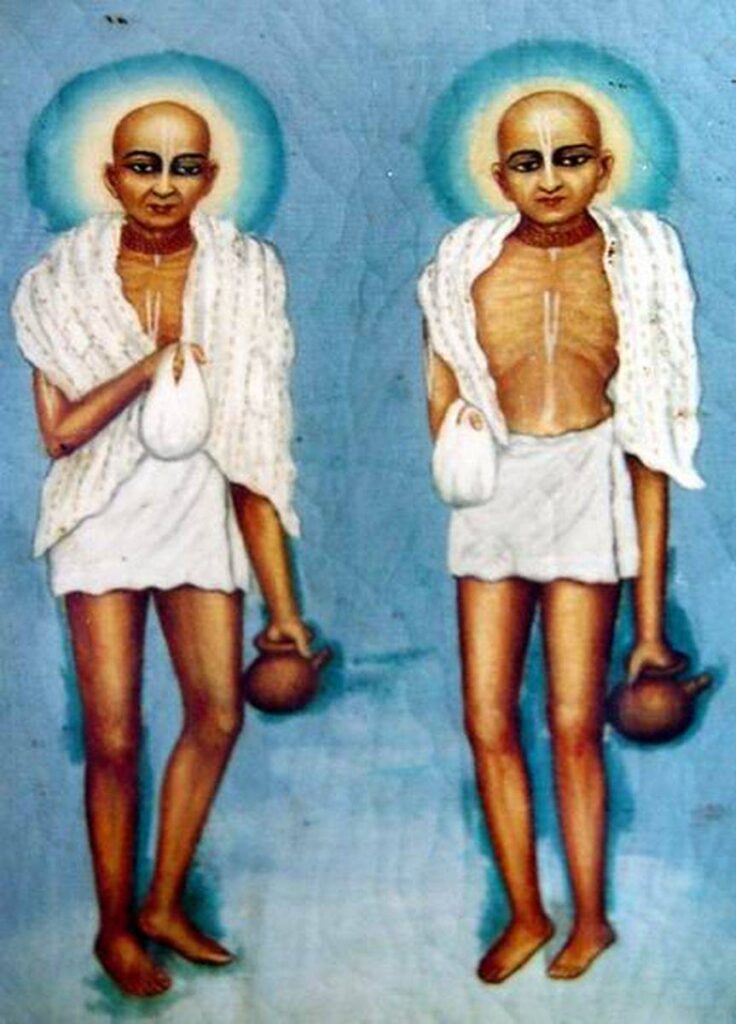
Rupa Goswami and Sanatan Goswami
[*The Bhagavata-sandarbhas or Sat Sandarbhas were composed by Srila Jiva Goswami. The word “sandarbha” literally means “weaving” or “arranging.” The Bhagavata-sandarbha, said to be Jiva Goswami’s main philosophical work, is a thematic arrangement of the Srimad Bhagavatam [Bhagavata Purana], which presents Lord Chaitanya’s Vaisnava philosophy in a systematic and comprehensive way.]
Therefore, the members of the Sri Visva-Vaisnava-raja-sabha are those people whose hearts have been illuminated by the light of the Sat-sandarbhas. Srila Sarasvati Thakur explained that when the world suffers misfortune and when there was apathy to such pure knowledge, the sabha conceals itself. After the disappearance of Srila Visvanatha Cakravarti Thakur and Srila Baladeva Vidyabhusana, the sabha was self-concealed for some time.
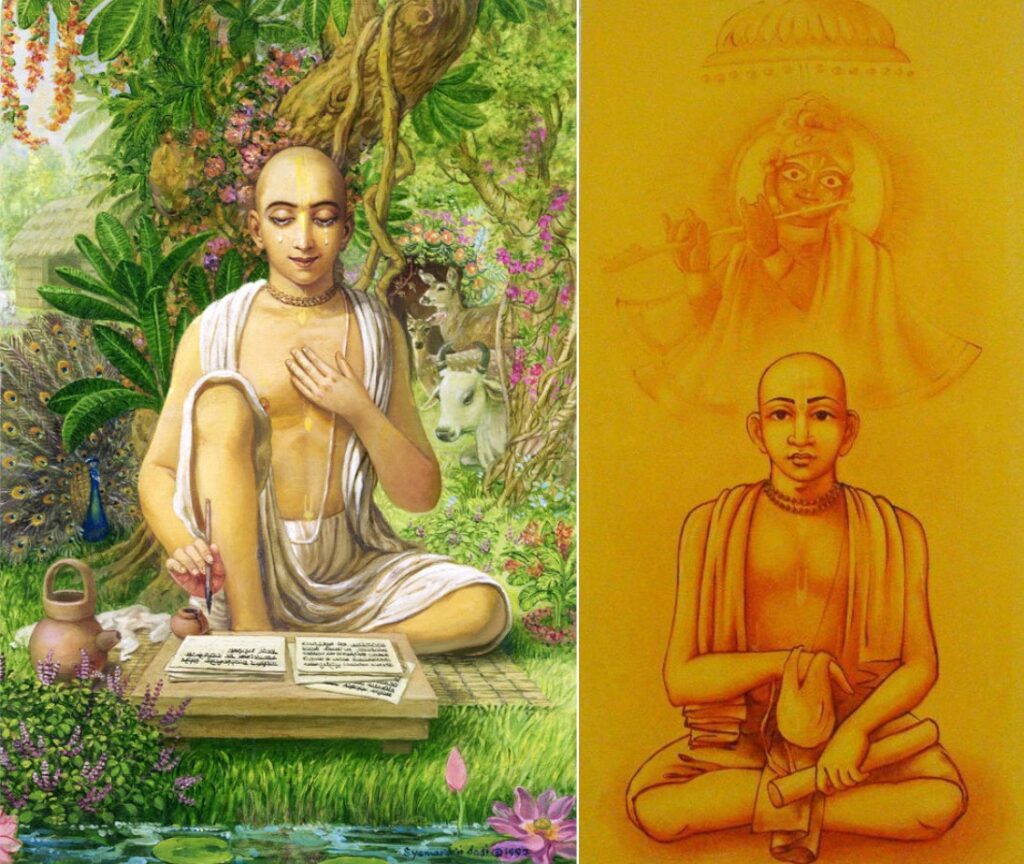
Srila Visvanatha Cakravarti Thakur and Srila Baladeva Vidyabhusana
The famous Calcutta paper Amrita Bazar Patrika reported the event in this way in 1919:
On Wednesday last [5th instant] was celebrated with great eclat the Advent ceremony of Sree Sree Vishnupriya Devi at the Sree Asana [1, Ultadanga Junction Road]. The occasion was solemnised by the re-institution of Visva-Vaisnava-raja-sabha as inaugurated by no less a personage than Sree Jiva Gosvami himself, eleven years after the passing of Sree Sree Mahaprabhu and as given a fresh impetus by Sree Bhaktivinoda Thakura 33 years ago.
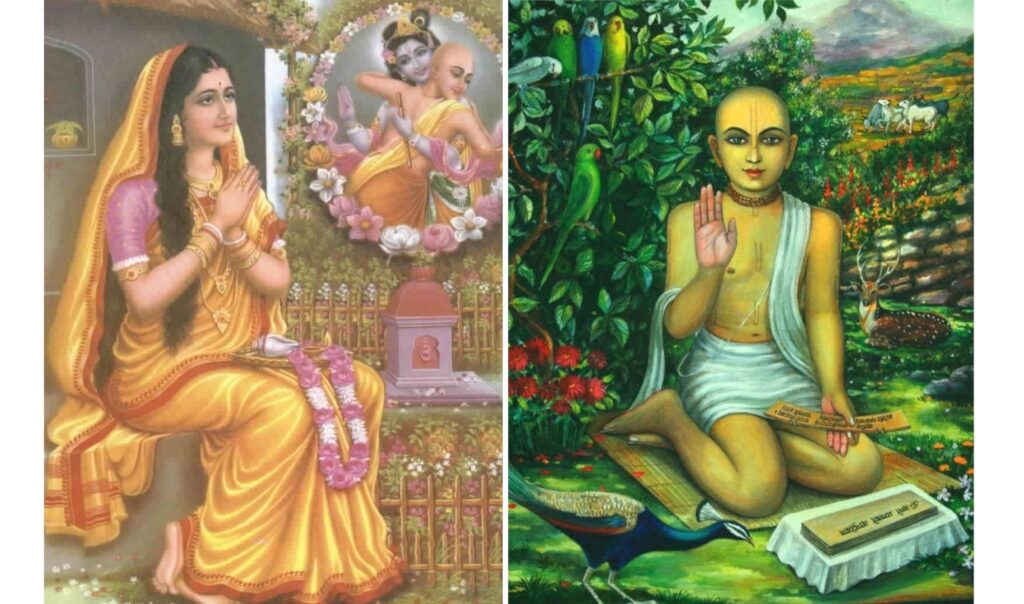
Sri Vishnupriya Devi and Srila Jiva Goswami
Following the re-institution of the Visva-Vaisnava-raja-sabha, a large meeting was held at the Bengal Literary Society to honour Srila Bhaktivinoda Thakur, and many famous speakers honoured him on that occasion. On Srila Bhaktivinoda Thakur’s Appearance Day an enormous festival was held for him at the Asana, at which time 1200 kilograms of rice were prepared, and thousands were served prasadam. It was observed by Srila Sarasvati Thakur’s followers that after that occasion there was never any lack of funds or other hindrances to any of his plans or desires. Whatever he desired was seen to manifest. This is a good example of the power of guru-puja. By properly honouring the pure representative of Godhead, the grace of the Lord is invoked, and all success is bound to follow.
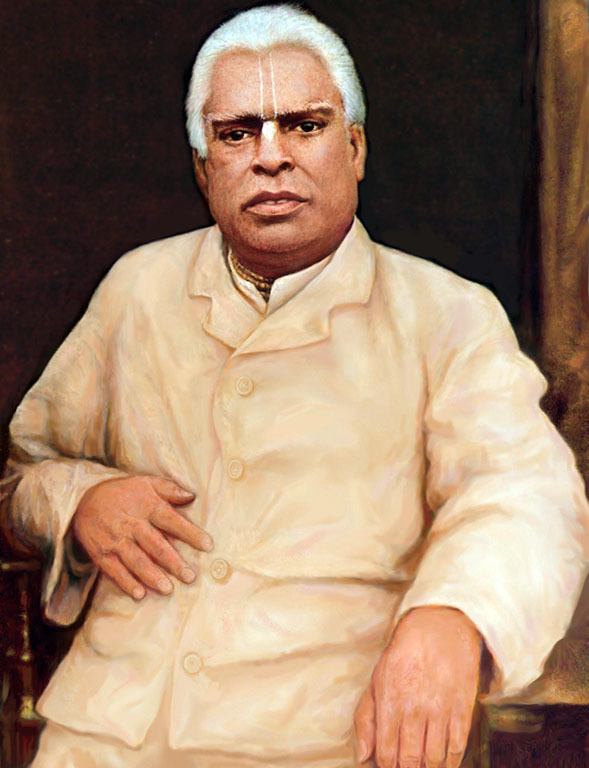
The living situation at the Bhaktivinoda Asana at Ultadanga Road was that Bhaktisiddhanta Sarasvati Thakur lived on the roof in one nice room, and four household couples lived below. The sannyasis and brahmacaris stayed in another area, begged from door-to-door, worshipped the Deities, performed kirtan, and preached in various places. In 1920 the Asana was renamed the Gaudiya Math and in 1922 began the publishing of a weekly magazine in Bengali, called the Gaudiya, which was filled with preaching and glorification of the Lord.

No 1 Ultadanga Road newly renovated. Below: Bhaktisiddhanta Sarasvati’s room (at very top)
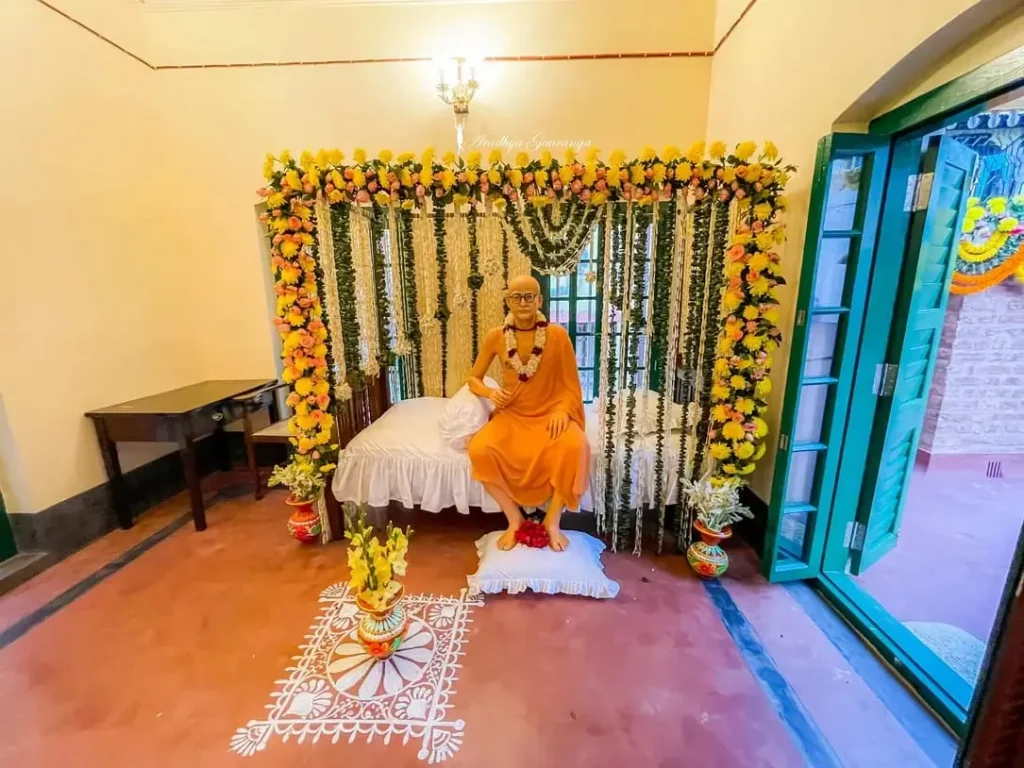
It was there in 1922 that the fateful meeting with His Divine Grace A.C. Bhaktivedanta Swami Prabhupad took place. The seed was then planted by Srila Bhaktisiddhanta Sarasvati Thakura that would lead to the fulfillment of his heartfelt desires and the predictions of Srila Bhaktivinoda Thakur and Lord Chaitanya: the chanting of the Holy Name would be spread all over the world. So it was in the very beginning days that the two transcendental titans met by transcendental arrangement.
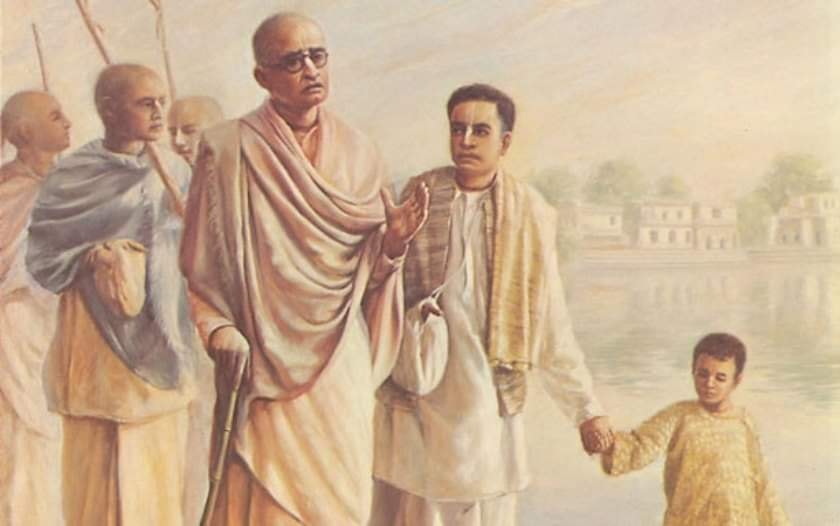
Srila Bhaktivedanta Swami hearing from Bhaktisiddhanta Sarasvati
As Srila Bhaktivedanta Swami Prabhupada later commented:
In 1896 Bhaktivinoda Thakur wanted to introduce this Krishna Consciousness Movement by sending his, this book, “Sri Caitanya Mahaprabhu His Life and Precepts.” Fortunately, that year was my birth year, and by Krishna’s arrangement we (Srila Bhaktisiddhanta Sarasvati Thakur and Srila Bhaktivedanta Swami) came in contact. I was born in a different family, my Guru Maharaja was born in a different family. Who knew that I would come to America? Who knew that you American boys would come to me? These are all Krishna’s arrangements. We cannot understand how things are taking place.
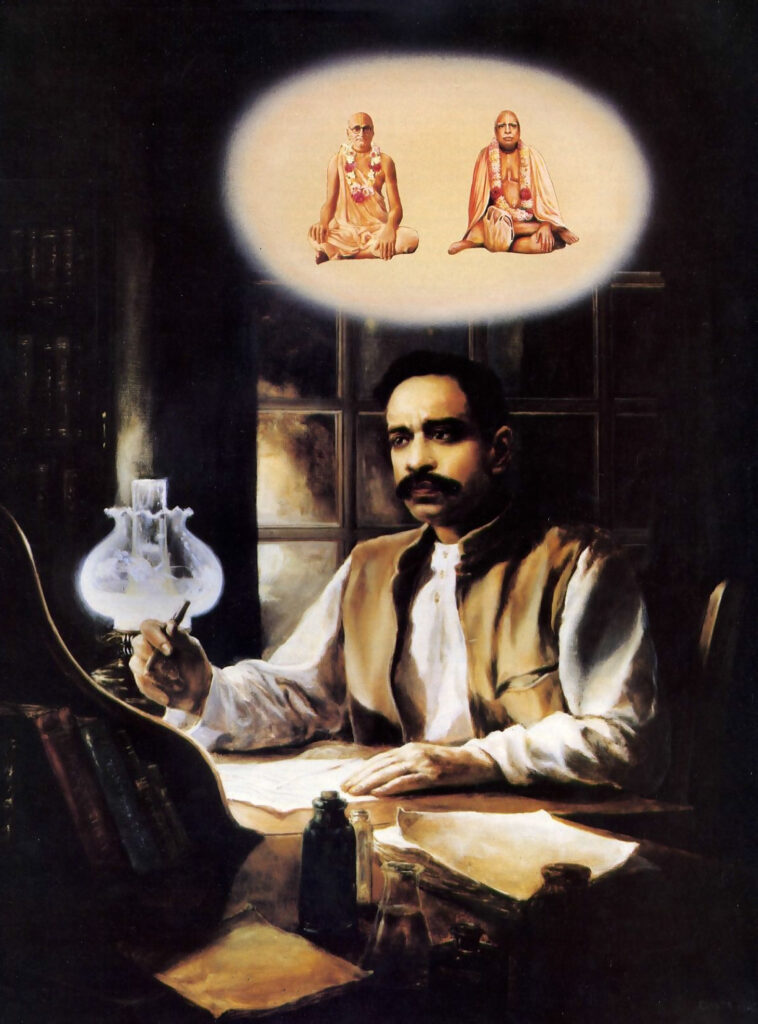
In the course of his preaching, Srila Sarasvati Thakur personally travelled all over India from the Himalayas to the ocean, and in that course he circumambulated Navadvipa-dhama, Gauda-mandala (holy places of Bengal), Ksetramandala (holy places of Orissa), Vraja-mandala (holy places of Vrindavan) and the whole of India, accompanied by many followers and wonderful sankirtan. A detailed catalogue of Srila Bhaktisiddhanta Sarasvati Thakur’s active preaching in these years would fill many volumes, so a few highlights will be mentioned.
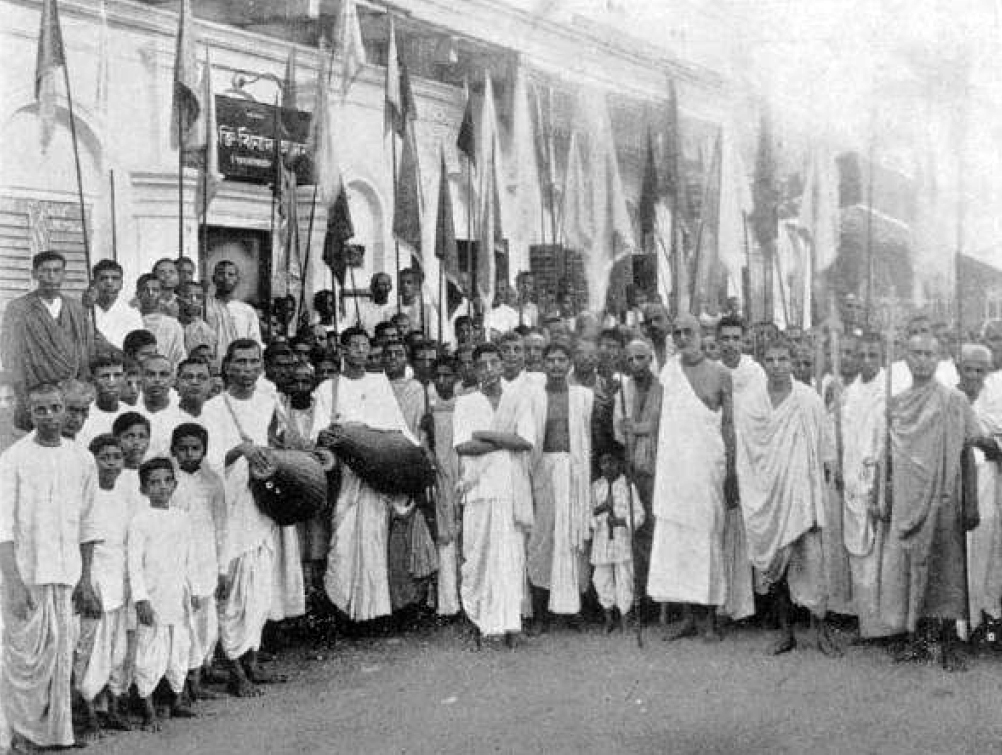
On June 27th, 1919, the deity form of Srila Bhaktivinoda Thakur was installed at Navadvipa in Godruma-dvipa at Svananda-sukhada-kunja, (the former residence of Srila Bhaktivinoda Thakur) at which time Srila Sarasvati Thakur gave a profound lecture about service to the guru and worship of the deity form of the acarya. He also arranged for the completion of the Vaisnava-viswakosh, an encyclopedia of Vaisnava vocabulary, which was the fulfillment of a desire of Srila Bhaktivinoda Thakur, and for which Srila Sarasvati Thakur had been collecting material since 1900.
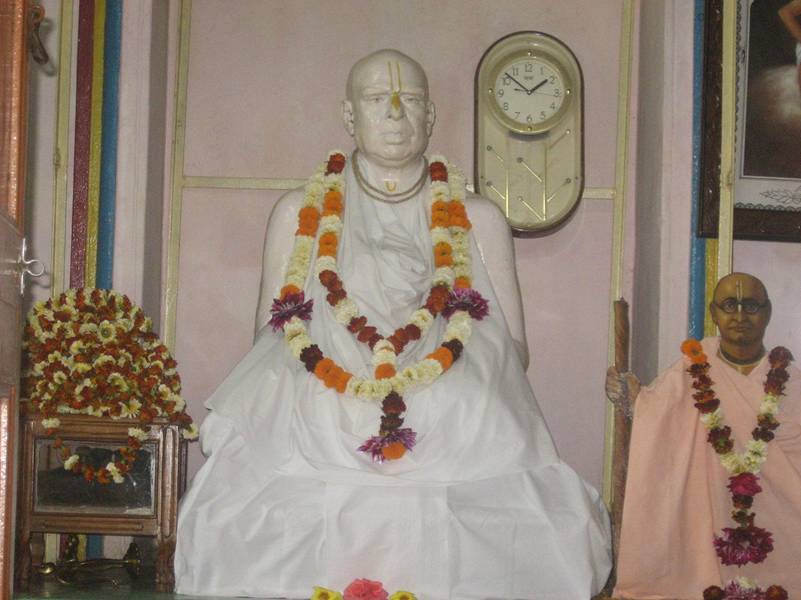
Deity form of Srila Bhaktivinoda Thakur
In 1921, in Puri, he published a book called Achar and Acharya which served as a great shock for so-called Vaisnavas who had been making a business of religion. Srila Bhaktisiddhanta condemned temple proprietors who made a business of showing the Deity for a living. To be a sweeper in the street was more honorable, he said. He coined a Bengali phrase, salagrama-dvara badam bhaìga:
The priests are taking the Salagrama Deity as a stone for cracking nuts.
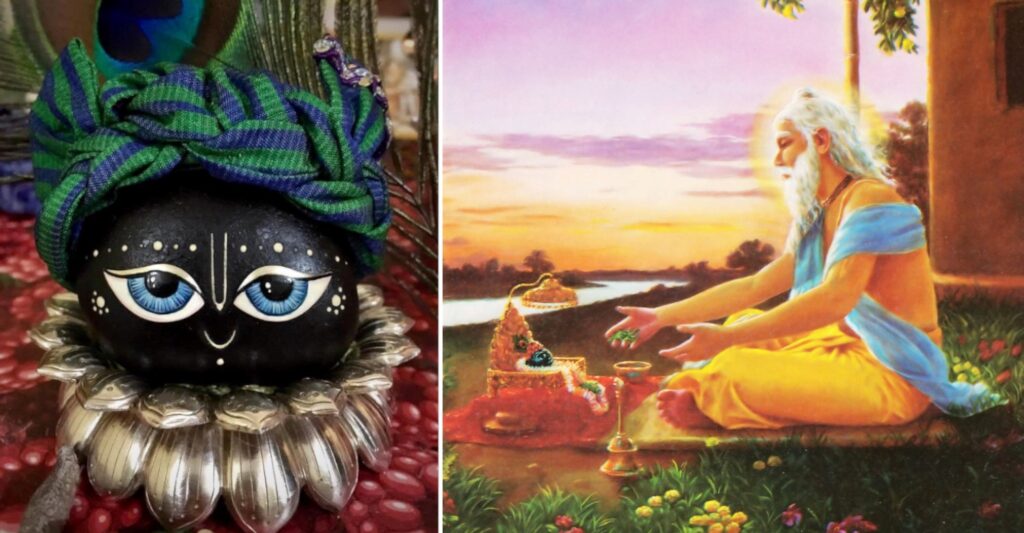
Salagrama sila deity. Right: Sri Adwaita worshiping His salagrama deity of Krishna
In other words, if a person shows the Salagrama form of the Lord (or any form of the Deity) simply with a view to make money, then he is seeing the Deity not as the Lord but as a stone, a means for earning his livelihood. Srila Bhaktisiddhanta Sarasvati Thakur revived the circumambulation of Navadvipa-dhama in the same year (1921) and gave an amazing lecture in Dacca giving 30 interpretations of a single verse of the Vedanta-sutra. He toured Vrajamandala during this period, trying to start a center there. In 1923 he attended the Puri Ratha-yatra and danced before the Lord in ecstasy. He began to send out many preaching parties to propagate the message of Lord Chaitanya. In 1923 he also set up the Gaudiya Printing Works in Calcutta and began to publish the Srimad Bhagavatam part by part, with word-for-word meanings, translations and purports.
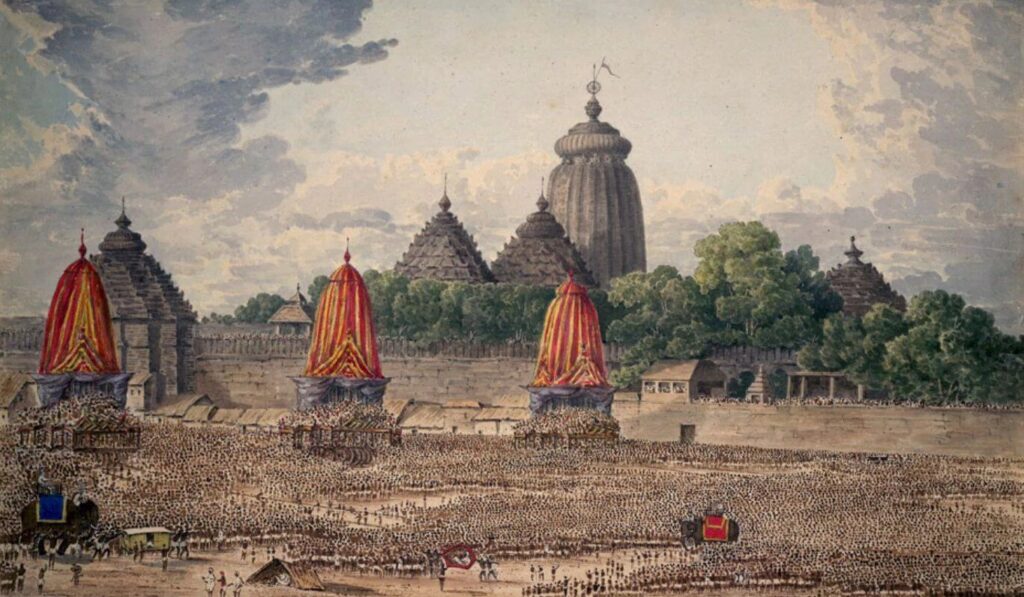
The Rathayatra Festival at Jagannath Puri
Vrajapattana Temple
In 1923 at Vrajapattana in Mayapura, work was begun on a beautiful, twenty-nine pinnacled temple. Vrajapattana means “the place where Vrindavan is manifested.” This is where the house of Candrasekhara was located. His wife Malati, was the younger sister of Srimati Saci-devi. They had no children of their own, and when Jagannatha Misra, the father of Lord Chaitanya, left this world, Candrasekhara acted as the Lord’s father. He accepted Lord Chaitanya as his son and took full responsibility for Saci-mata.
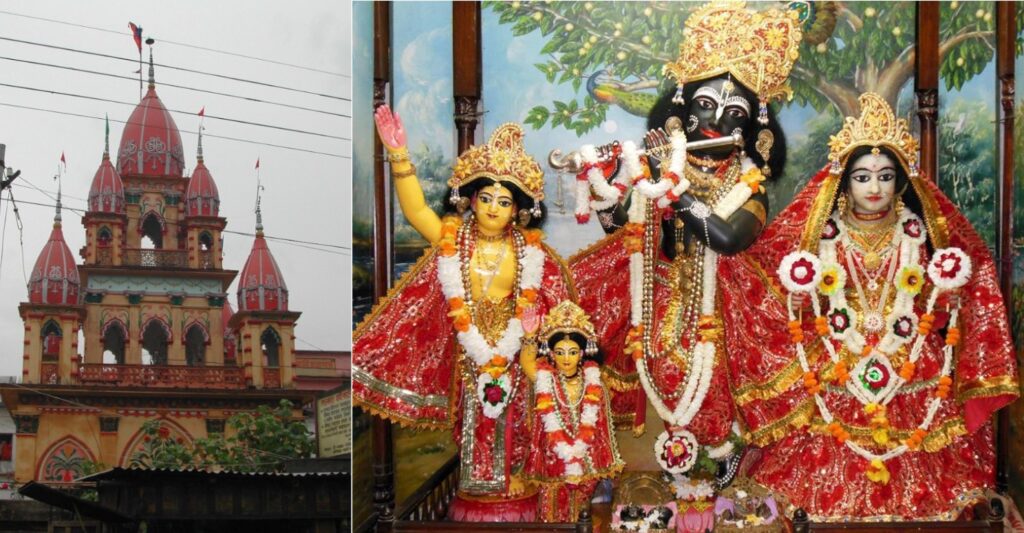
The main temple at Vrajapattana is dedicated to Sri Sri Gandharvika-Giridhari (Radha-Krishna). On the altar to the right of Gandharvika-Giridhari are two deities of Lord Chaitanya with Their right arms raised. When you walk around the deity chamber there are four altars, one for each of the Vaishnava acaryas: Sri Madhvacarya, Sri Vishnu Swami, Sri Nimbarkacarya and Sri Ramanujacarya.
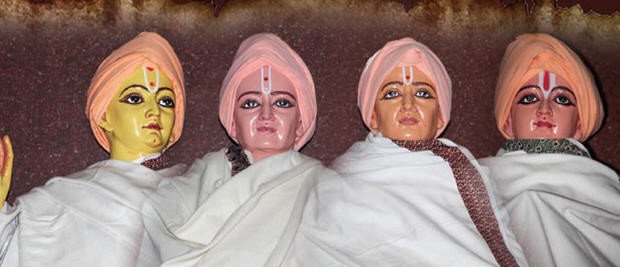
The Acharyas of the 4 Vaisnava Disciplic Successions
The Four Sampradayas
In the Vrajapattana Temple, the four Vaisnava sampradayas (disciplic lines) and their main acaryas are all honoured. On each outer corner of the building there is a deity alcove. In one we find the Brahma-sampradaya and Srila Madhvacarya, in another the Rudra-sampradaya and Srila Visnusvami, the Kumara-sampradaya with Srila Nimbarkacarya in another, and the Laksmi-sampradaya headed by Srila Ramanujacarya on the fourth corner. All of this can be seen as the temple is circumambulated. Srila Bhaktisiddhanta Sarasvati Thakur’s idea was that, although there are some distinctions in the teachings of the Vaisnava acharyas, they are united in their opinion that the Lord is the Supreme Eternal Person, meant to be served eternally by the eternal living beings. They had also all written commentaries on the Vedanta, refuting the impersonal teachings of Sankaracarya.

Srila Madvacarya and Srila Vishnuswami
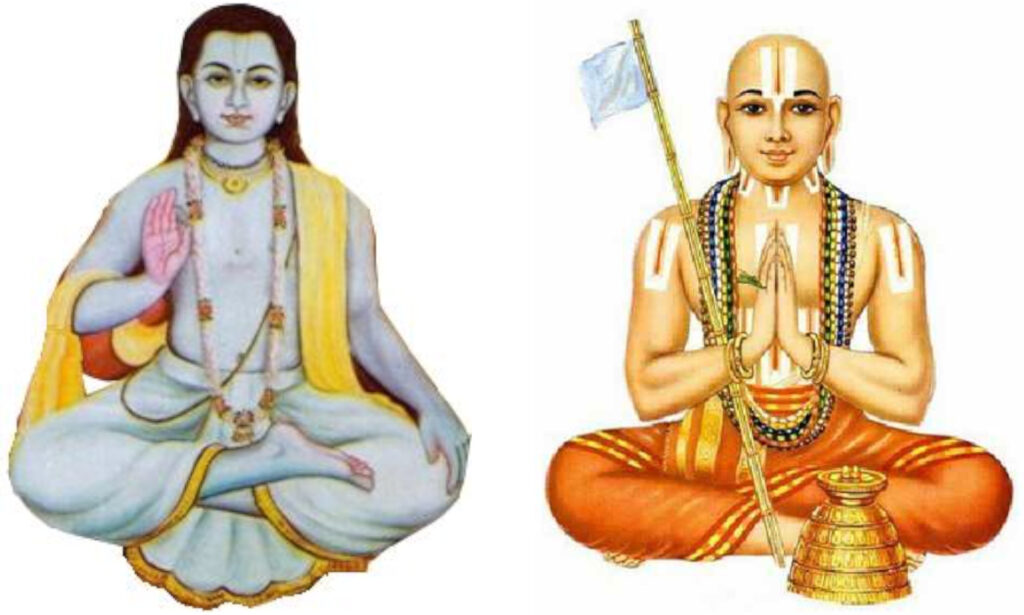
Srila Nimbarkacarya and Srila Ramanujacarya
Sri Chaitanya Mahaprabhu praised certain conclusions of each acharya:
1. From Srila Madhvacarya – his refutation of the Mayavada doctrine and the worship of the form of Lord Krishna, knowing it to be eternal.
2. From Srila Ramanujacarya – pure devotion and service to the Vaisnavas.
3. From Srila Visnusvami – the attitude of God being one’s all and all and the raga-marga path of spontaneous devotion.
4. From Srila Nimbarkacarya – the *raga-marga and performing bhajan following in the footsteps of the gopis.
[*raga-marga: the path of spontaneous love]
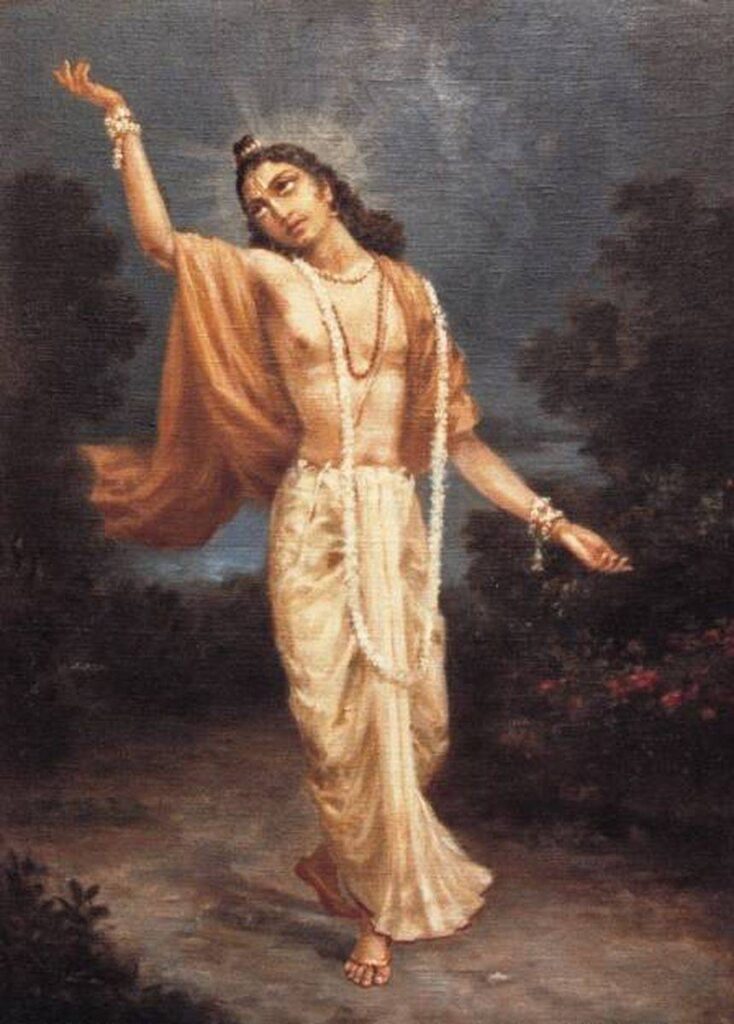
By establishing the acintya-bhedabheda-tattva siddhanta, Lord Chaitanya had perfected and completed the Vaisnava philosophy, and to make this widely understood was Srila Bhaktisiddhanta Sarasvati Thakur’s mission. The doctrine of acintya-bhedabheda-tattva as taught by Lord Chaitanya establishes that the Supreme Lord and the individual souls are inconceivably simultaneously one and yet different. They are one in quality, in the sense that they are both eternal spiritual beings, but they are different in quantity – the Supreme Lord is infinite, whereas the minute jiva souls are infinitesimal. The analogy is sometimes given that a drop of sea water is the same in quality as the ocean – it is wet and salty. But the drop of sea water is in no way equal to the entire ocean in quantity.
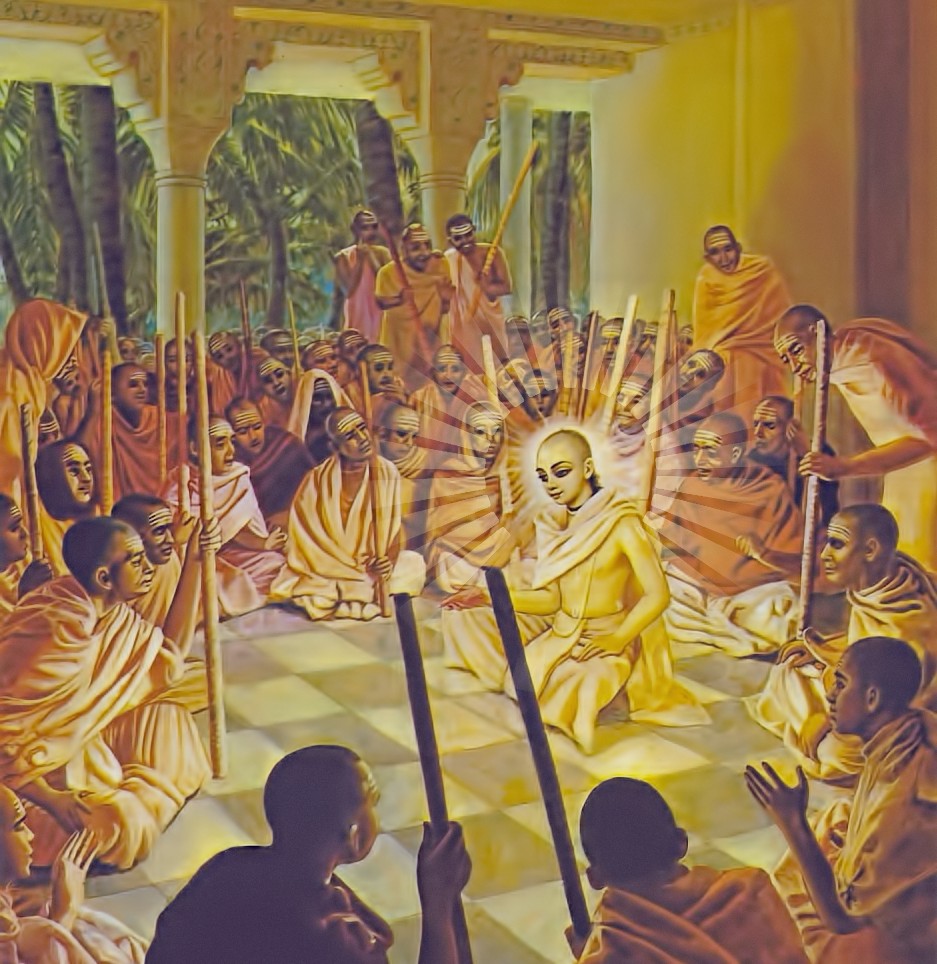
Lord Chaitanya enlightening Prakasananda Sarasvati and his impersonalist followers
Srila Bhaktisiddhanta Sarasvati Thakur had gone to all the places of the four acharyas, studied their books, their Deity Worship, etc. and he published many of their writings, along with their life histories. His attempt was to unify the Vaisnava world by propagating the sublime teachings of Lord Chaitanya in the form of the writings of the Six Gosvamis of Vrindavan, especially Srila Sanatan Gosvami, Srila Rupa Gosvami and Srila Raghunatha Das Gosvami, who are the Gaudiya acharyas of sambandha-tattva, abhidheya-tattva, and prayojana-tattva, respectively. These three acharyas committed to writing the teachings of Sri Chaitanya Mahaprabhu as they heard it from Him and His two most intimate associates: Srila Svarup Damodar Gosvami and Srila Ramananda Raya. Srila Svarup Damodar was an incarnation of Visakha, and Ramananda Raya was an incarnation of Lalita – Radharani’s most intimate gopi friends.
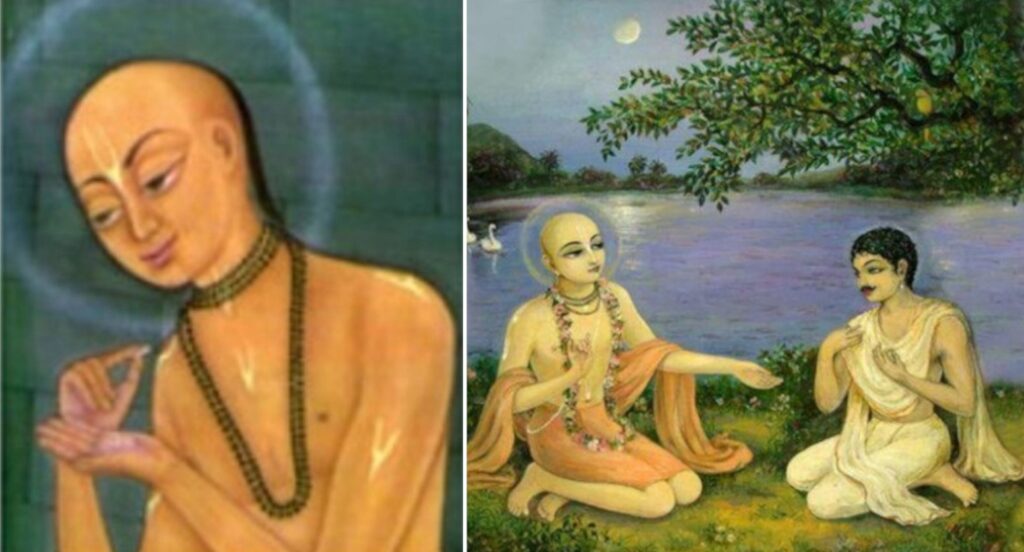
Svarup Damodar and Ramananda Raya
The Gosvamis established everything on the basis of exhaustive scriptural research, strong logic and ecstatic realization of the Absolute Truth. On February 24, 1924, on Srila Bhaktisiddhanta Sarasvati Thakur’s 50th birthday, the Sri Vyasa-puja celebration was inaugurated. On that occasion he gave a remarkable and often-cited lecture called Be Humbler Than A Blade of Grass. I have quoted a few of the final paragraphs of this amazing essay below:
If we disregard or ignore the devotees of God for elevating ourselves, we would thereby be cast into the prison of three dimensions and spring towards inflation instead of contraction. “I will be good; I will be cured of my mundane desires; I will have real well-being.” This is the proper kind of judgment. But it is not at all laudable to entertain the contrary thoughts: “I will be great, I will gratify my malice by stopping the course of the whole world.” It is by no means proper to set up one’s superiority against the worshipfulness of God’s devotees. The path of hearkening to the Transcendental Word has been rendered devious by the misinterpretation of the text “Aham Brahmasmi.” I have listened to the true interpretation of the text at the lotus-feet of my Divine Master. It is to this effect, “It is our eternal duty to chant constantly the Name of Hari by being infinitely more truly humble than the smallest blade of grass, more truly forbearing than even the proverbially patient tree, and to honour others without seeking honour.”
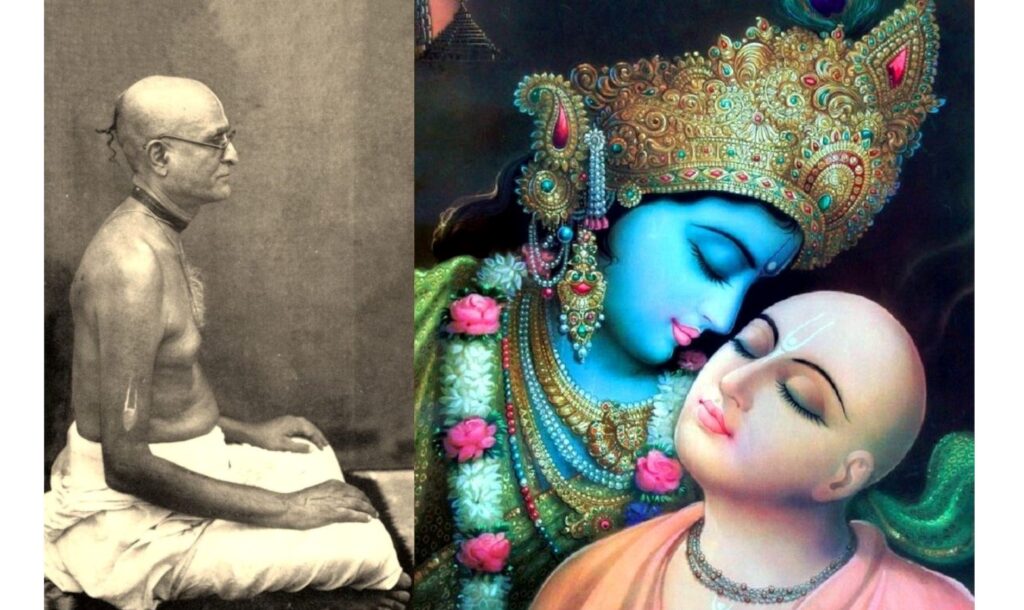
What persuasive courtesy, what humility do these words express! How great is the benefit, how great the good that we may have by listening to such words! We have it from the Talaba Upanishad that those who aspire to be masters of the devotees, who are the masters of God Himself, are indeed, most culpably arrogant. Srimad Bhagavatam significantly declares, “Let those who profess to know God brag of their knowledge, but let me have nothing to do with such fellows. This is all I have got to say in this matter.“
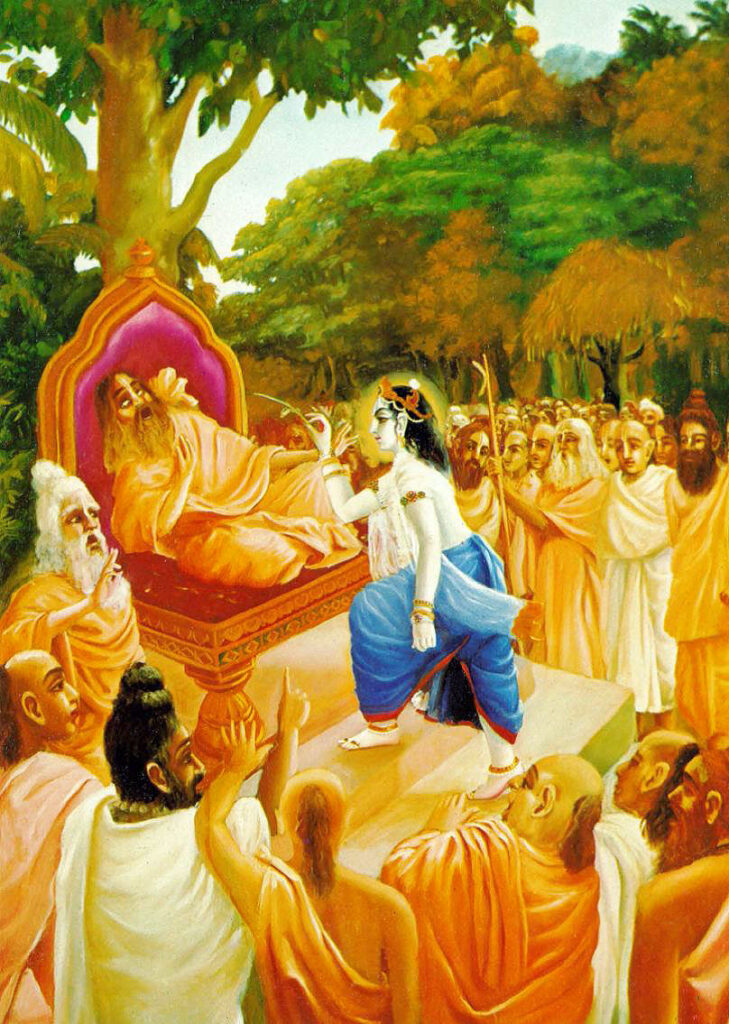
Romharsana Suta was acting as an enlightened spiritual master, but he did not recognize Lord Balarama as the Supreme Lord, and was therefore cheating others by playing the role of guru
Not one among the paths of this material world is a path of the service of the Divinity. The idea that one should be master of God’s devotees leads to inferno. It is harmful to follow any worldly path. To follow the devotees of God is the only path that leads to one’s real good. Whatever method is followed by the devotees is worthy of being cherished with the utmost love and reverence.
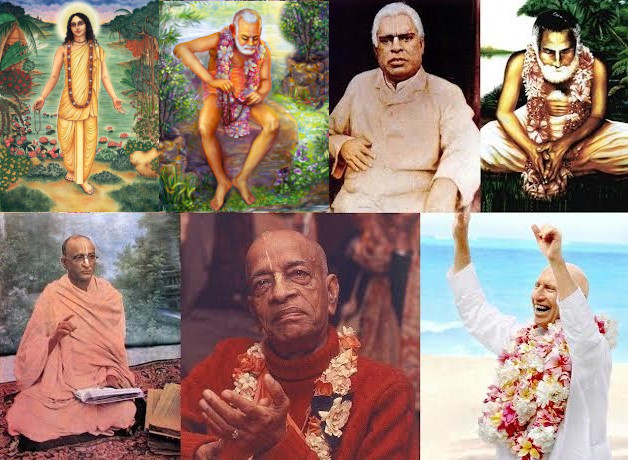
To follow the devotees of God is the only path that leads to one’s real good
Holding the blade of straw between my teeth I pray time and again for this only boon, that I may be a particle of dust of the lotus-feet of the most revered Shri Rupa Goswami Prabhu. Let there be birth after birth for us that we may walk in the path of the followers of Shri Rupa by being the particles of dust on the lotus-feet of the devotees of God. The root of it all is humility or the due realization of one’s own ineligibility. If the conviction of our unfitness for the service of God is revealed to us either automatically or by the instruction of other persons, we are only then in a position to appreciate the beauty of the lotus-feet of God’s devotees. In all the talks of the average people of this world the idea that is uppermost is how to promote the gratification of one’s senses. If we happen to be obsessed with the idea that it is the path of religion, we would be prevented for good from becoming truly religious.
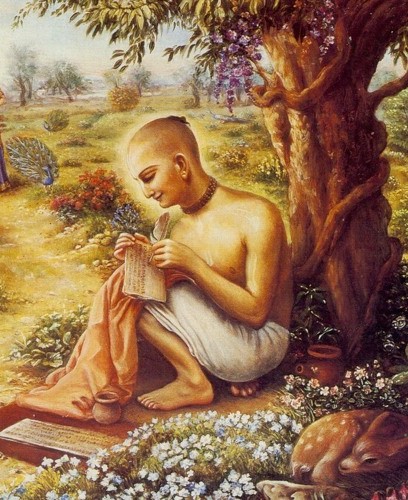
Srila Rupa Goswami
All persons are accustomed to worship the Beautiful Feet of God. But the conception that God is to supply our comforts and conveniences in lieu of worship is worthy of a shop-keeper. That we are to receive some other things in exchange for our worship is not the trend of thought of the devotees of God. If one seeks to follow such a course, one will never understand the nature of the service of Krishna. God is full of the highest well-being. It is no proof of one’s goodness of judgment to pray to God for the gratification of one’s senses instead of the highest good. It should be the duty of all persons to follow the line of thought that seeks to find out how Krishna is to be served.

Oh my Lord, I pray to Thee for being employed in Thy service. I will no more serve dogs and horses, iron and gold, men and gods. I have courted my own destruction by engaging in their service. Thy service, O Lord, is the only means of being delivered from this dire misfortune. But it is a far cry to seek to obtain Thy service without serving those who have dedicated themselves to Thy service. The service of Thy devotees is productive of greater good than any other method.
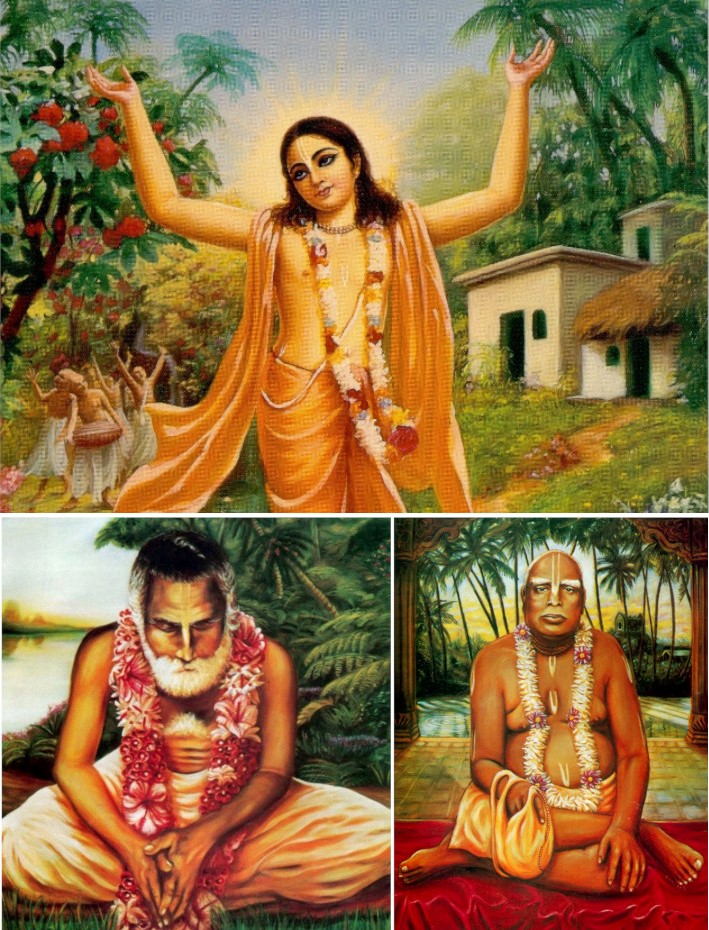
We do not find God in this world. The devotees, who serve God, out of their mercy show themselves to us. We should follow their conduct and teaching. It is the only path to our well-being. Due to our meager education and small experience, to most of us the ideas and ways of thinking of the devotees of God appear to be unedifying “slave mentality.” Let us not indulge in such profane ravings under the urge of mental aberration. On the contrary, our line of thought should be, “Let the censorious people calumniate us (utter maliciously false statements) to their hearts’ content. We will not mind them. Let us roll in the dust and forget everything in the ecstasy of intoxication by excessive drinking of the strong and tasty wine of the love of Lord Hari.
[Published in The Harmonist (Sree Sajjanatoshani)]
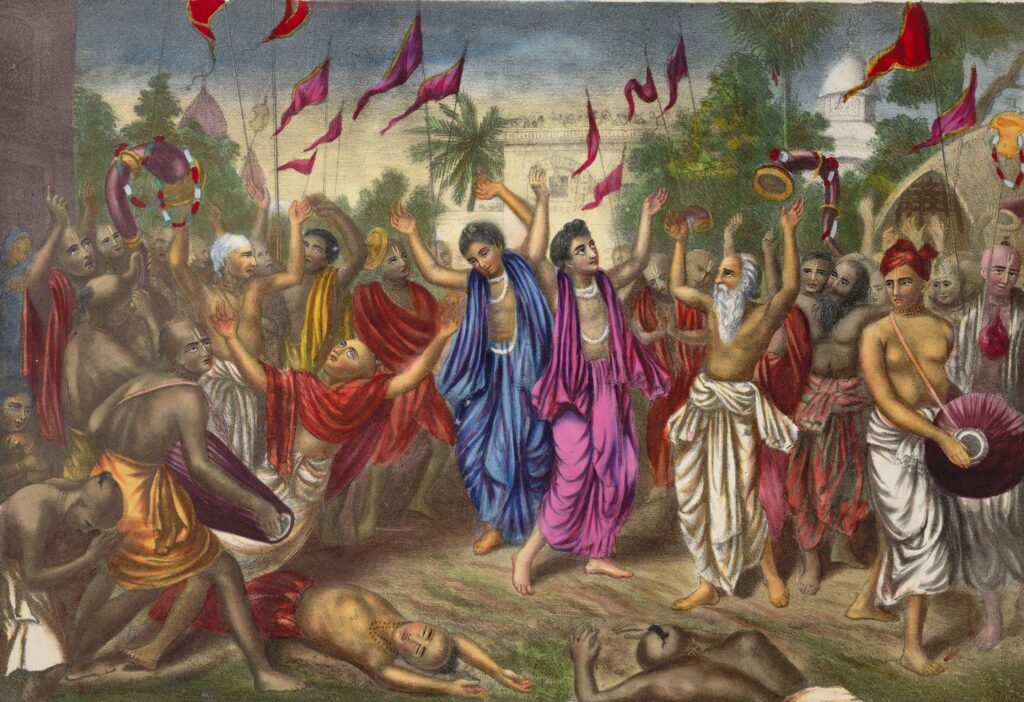
Srila Sarasvati Thakur’s references here to “slave mentality” can be understood to be, at least in part, the reaction of the Indian intellectuals of his time, who had been bewildered by a false presentation of their own culture and religion. As the British had successfully brainwashed many intellectuals in their educational institutions by making them think that their religion was barbarous, backward, etc., the Indians sometimes took it that the ways of the Vaisnavas represented something useless from their past to enslave them in the stereotype fostered by the British of foolish, illiterate “Hindoos.”
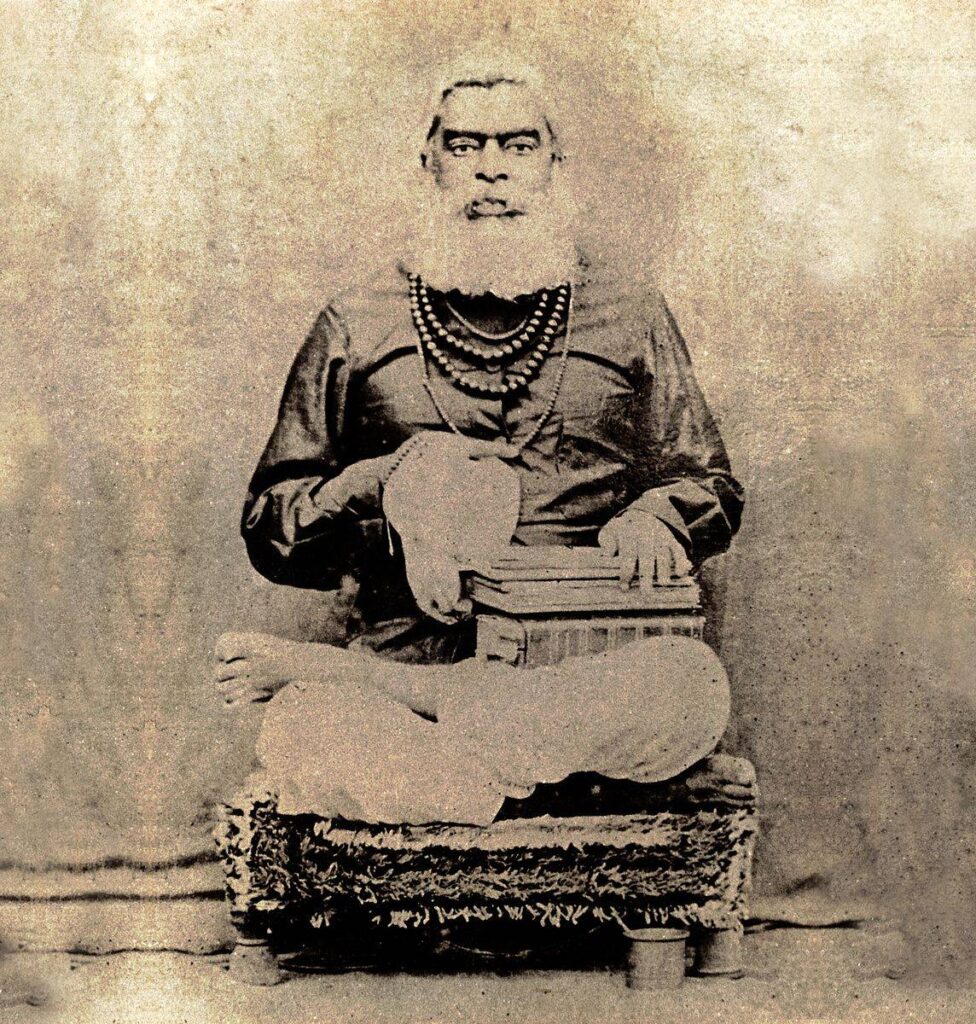
Srila Bhaktivinoda Thakur comments on this in his book, The Bhagavat (Srimad Bhagavatam):
What sort of a thing is the Bhagavat? asks the European gentleman newly arrived in India. His companion tells him with a serene look, that the Bhagavat is a book, which his Oriya bearer daily reads in the evening to a number of hearers. It contains a jargon of unintelligible and savage literature of those men who paint their noses with some sort of earth or sandal, and wear beads all over their bodies in order to procure salvation for themselves. Another of his companions, who has travelled a little in the interior, would immediately contradict him and say that the Bhagavat is a Sanskrit work claimed by a sect of men, the Gosvamis, who give mantras like the Popes of Italy, to the common people of Bengal, and pardon their sins on payment of gold enough to defray their social expenses.
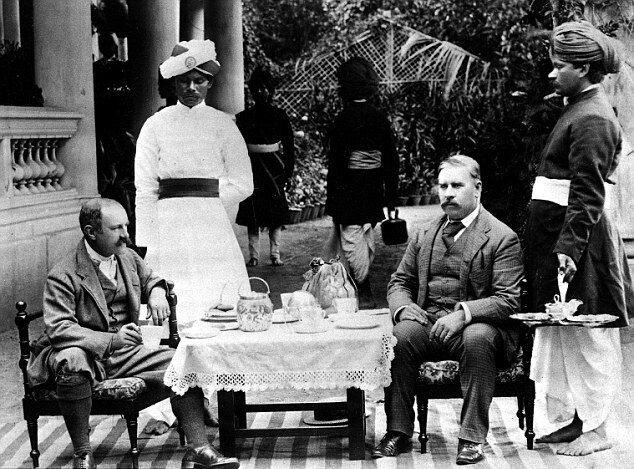
A third gentleman will repeat a third explanation. Young Bengal, chained up in English thoughts and ideas, and wholly ignorant of the pre-Mohamedan history of his own country, will add one more explanation by saying that the Bhagavat is a book, containing an account of the life of Krishna, who was an ambitious and immoral man! This is all he could gather from his grandmother while yet he did not go to school! Thus the Great Bhagavat ever remains unknown to the foreigners like the elephant of the six blind men who caught hold of the several parts of the body of the beast! But Truth is eternal and is never injured but for a while by ignorance.
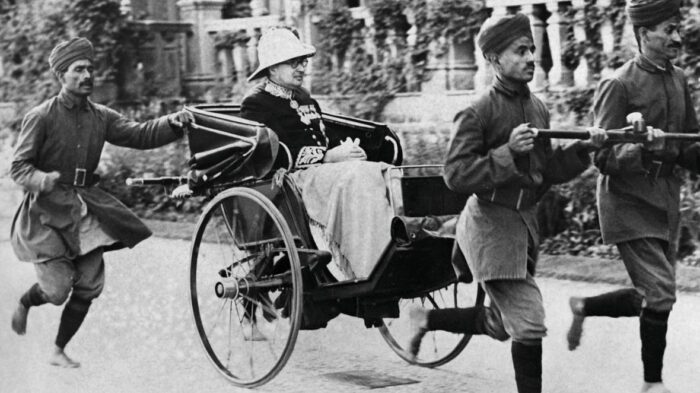
Srila Bhaktivinoda Thakur, herein clearly describes the situation that he, and later, Srila Sarasvati Thakura were forced to combat in their preaching. Bengalis, in particular, and Indians, in general, had largely been made into foreigners in their own land, due to the British Sanskritists and educators, who had portrayed Vedic literature and culture as something recent, barbaric, and inferior. Srila Bhaktivedanta Swami Prabhupad once commented that by this tactic, the British were able to do more harm to Indian culture and religion in their short period of rule than the Moslems were ever able to do in their much longer one. To this day, although Indian pride in their great cultural and religious antecedents is more developed due to the efforts of Srila Bhaktivinoda Thakur, Srila Sarasvati Thakur, Srila Bhaktivedanta Swami and others, still the Sanskrit dictionaries, text books on Indian religion and culture, etc. reflect this cultural bias, the result of deliberate undermining work done by the British in Indological studies with the disguised intention of asserting the superiority of their own cultural values and outlook.
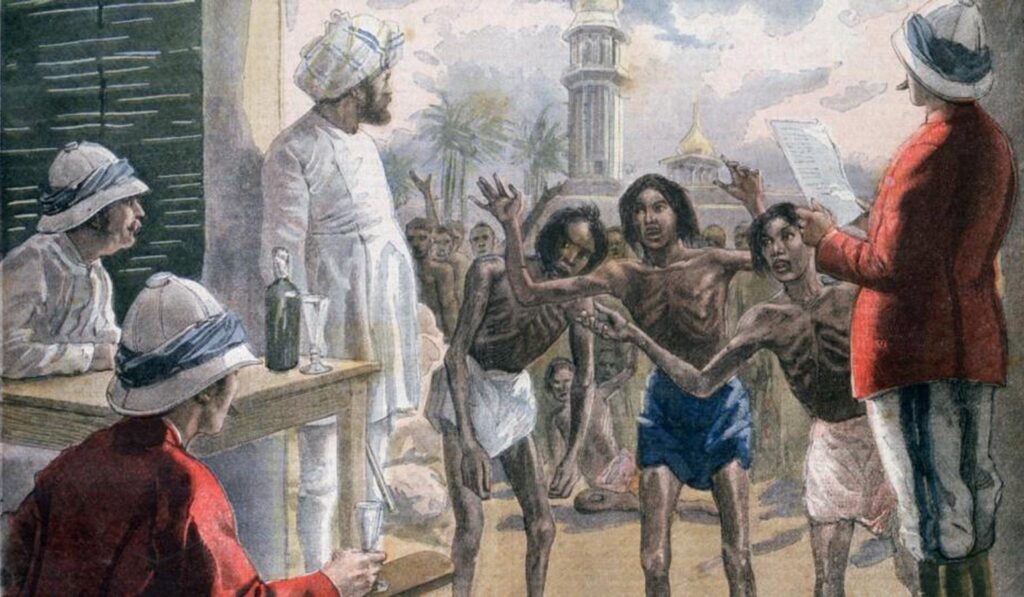
Later in 1924, Srila Bhaktisiddhanta Sarasvati Thakur travelled and preached vigorously, establishing a temple in Bhubaneswar and preaching in Orissa, Dacca, Benares, and Allahabad, where he located the spot where Lord Chaitanya imparted His teachings to Srila Rupa Gosvami at the Dasasvamedha-ghata. In 1925, Srila Bhaktisiddhanta Sarasvati Thakur and his followers were performing the circumambulation of Navadvipa-dhama, which had been a regular practice since 1921. The procession was proceeding with the Deities mounted on the back of an elephant, and thousands of pilgrims were loudly chanting the holy name. This circumambulation had a great history beginning with Srila Jiva Gosvami being led on the circumambulation of the Dhama by Lord Nityananda Himself after the disappearance of Sri Chaitanya Mahaprabhu. This is recounted in detail in Srila Bhaktivinoda Thakur’s Navadvipa-dhama-mahatmya.
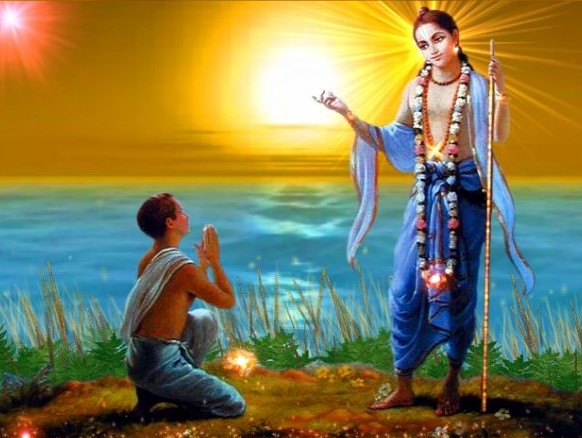
While Srila Sarasvati Thakur was proceeding with the roaring procession with the Deities of Sri Sri Radha Govinda, a vicious crowd attacked the procession throwing hundreds of stones and bricks. Demonic persons, agitated by the preaching of Srila Sarasvati Thakur (who had refuted the various bogus doctrines of the 13 Sahajiya sects like the Aulas, Baulas, etc.) had instigated the local people against him. Srila Sarasvati Thakur had also debunked, as he would throughout his preaching, the nonsense practices of compulsory fees for viewing Deities and the worship and recital of Srimad-Bhagavatam for money. He strongly opposed the conversion of the Deities and the Srimad-Bhagavatam into some sort of merchandise. Therefore, these persons who tried to profit by these practices, led and instigated the local populace to commit violence on the procession. Srila Sarasvati Thakur, the Deities and the pilgrims were all pelted by these demons, but the procession continued, unbowed. This was a living example of the adage:
The dogs bark, but the caravan moves on.
An eye-witness wrote in the Ananda Bazar newspaper:
Today, I saw the re-enactment of the activities which were carried out four hundred years ago towards Avadhuta Nityananda by the two wicked constables of Navadvipa at that time – namely Jagai and Madhai.
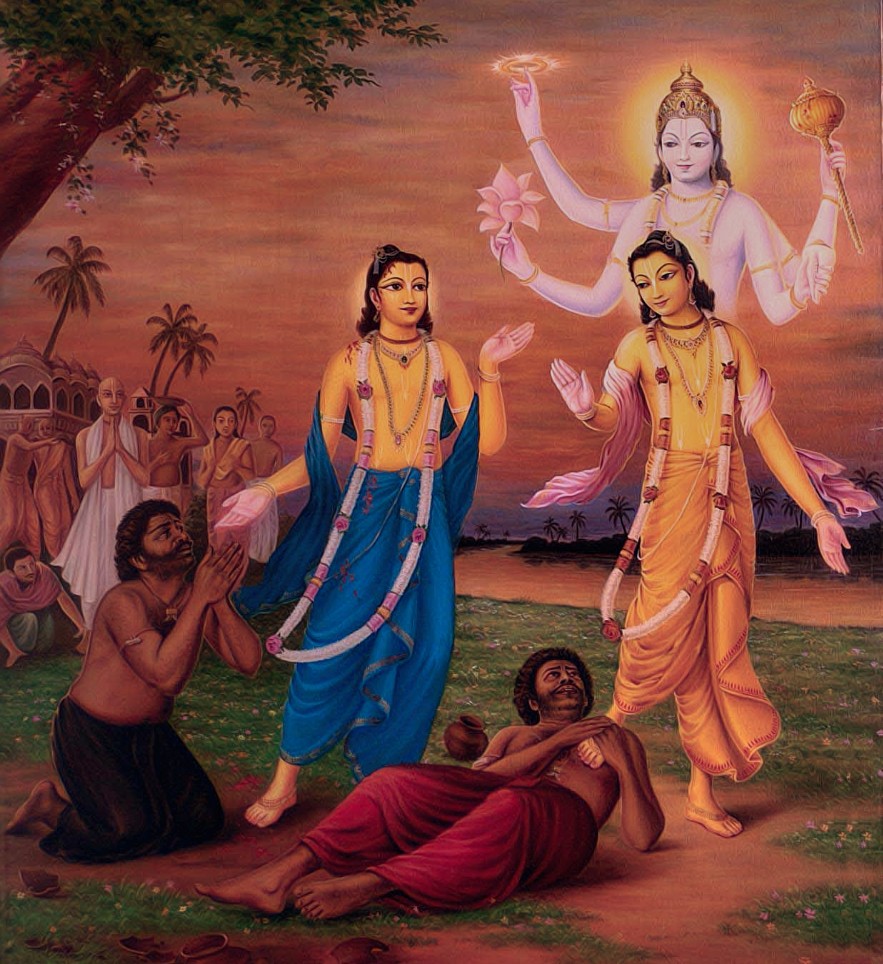
Jagai and Madhai are saved by the mercy of Lord Nityananda
In 1926 Srila Sarasvati Thakur sent his sannyasis out to Bengal, Bihar, Orissa, and Northwest India to start centers. He met with Vaisnava leaders and acaryas in Nathadwar, Bombay, Udupi and Salimabad, and he also established temples in Naimisaranya and Mayapur. He conducted the installation of the Deities and the forms of the Vaisnava acharyas at the Sri Chaitanya Math in Vrajapattana, Mayapur. In 1927 the Sajjana Toshani began publication in English, Sanskrit and Hindi, the English edition being entitled the Harmonist. He preached widely in Northern India and established more temples and even travelled as far as Assam. In 1928 at Kuruksetra, on the occasion of the solar eclipse, he preached to thousands and thousands of persons, while absorbed in the mood of separation of the gopis, and unveiled a diorama exhibition of Krishna’s meeting with the gopis, inducing everyone present to chant the names of Lord Chaitanya and Krishna. He also installed a Deity of Sri Chaitanya Mahaprabhu at a temple in Kuruksetra.
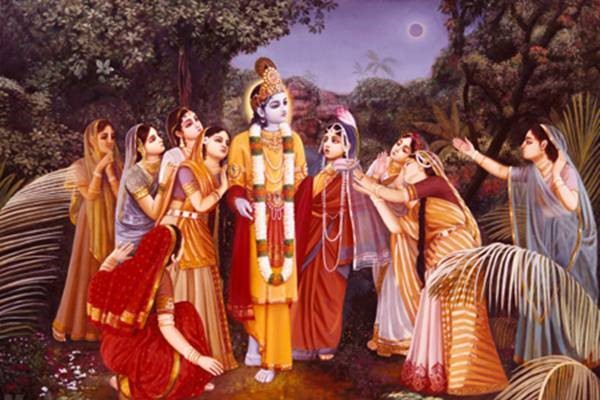
Krishna meeting the gopis at Kuruksetra
In 1929 Srila Sarasvati Thakur had a series of meetings with Professor Albert E. Suthers of Ohio State University and spoke to him on a number of topics, including Vaisnavism and Christianity, transmigration, evolution, idolatry, and Avataras. Professor Suthers had come from Bombay to do research for his course in comparative religions at Ohio State University. He went to Calcutta to meet Srila Sarasvati Thakur, who was at that time in Krishnanagar. So the professor journeyed there and heard from him for three days consecutively. The professor was initially very argumentative and skeptical, but was clearly very impressed with Srila Sarasvati Thakur’s presentation, and concluded his visit with a pilgrimage to the birthsite of Sri Chaitanya Mahaprabhu. These exchanges were very lengthy, and I have included the conversation they had on reincarnation, which obviously amazed and impressed the professor.
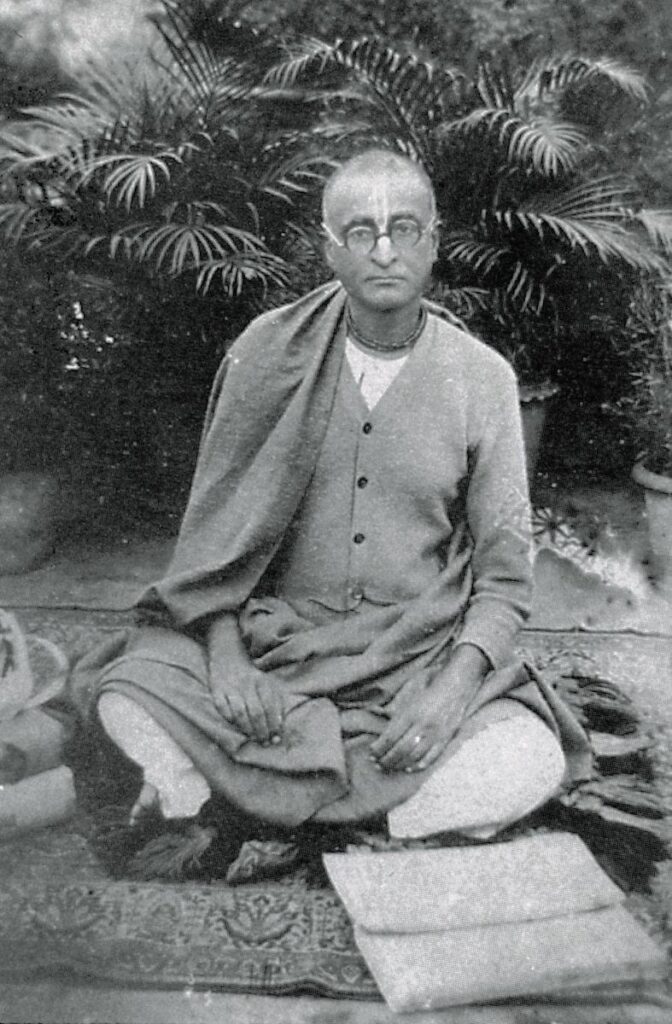
Professor Suthers: The Gita has admitted the doctrine of the transmigration of the soul. What does your Vaisnava philosophy say about this?
Srila Sarasvati Thakur:
The Gita is not separate from the Vaisnava philosophy. In the Srimad-Bhagavatam has been fully revealed the true import of the doctrine, viz., that of changes of births for the soul. Christianity has disregarded the principle of change of births on the alleged ground that if it is accepted, men will not restrain their sinful propensities, rather they will indulge in vices at their sweet will in their present life, on the expectation that they will be able to make good their sins, guilts, and wrong doing of this life in the course of the following ones. But the Srimad-Bhagavatam has crowned the principle with its true significance, by means of a much fuller scientific and philosophical meaning, by giving the instruction about the urgent necessity for ardently taking up and culturing devotion to God even while the human life, not easily available in the after-lives, is at our disposal, without spending a single moment thereof in other useless pursuits. If we do not accept the doctrine of transmigration of the soul and adopt the instruction of the Srimad-Bhagavatam, we shall not be able to get over the all-devouring disaster of regarding matter as the sole object of our concern, which has kept its mouth wide open. Though most of the Christians do not admit transmigration, yet many intellectual giants of the Christian world have shown several instances of their acceptance of the doctrine. Even in the Bible we find:
And as Jesus passed by, he saw a man who was blind from his birth. And his disciples asked him, saying, “Master, who had committed the sin? This man or his parents, that he was born blind?”
[St. John 9, 1-2]

It is seen that even some Christian Fathers clearly gave instructions about transmigration. Origen said:
Is it not more in conformity with reason that every soul for certain mysterious reasons is introduced into a body and introduced according to its deserts and former actions?
[Origen contra celscea, I xxxii]
I am sure that I, such as you see me here, have lived a thousand times, and I have to come again another thousand times. [Says Goethe].
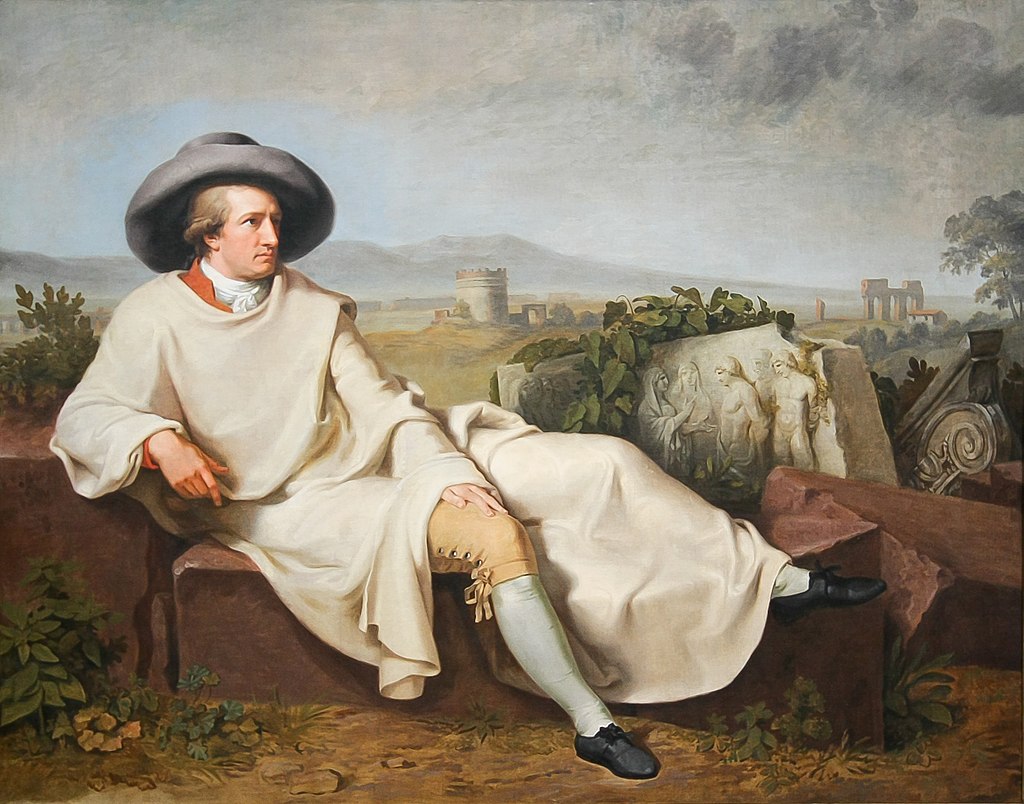
Goethe
What the Greeks called ‘Metempsychosis’ or what is ‘Transmigration’ in the English language, was at one time, more or less, admitted in ancient Greece, Egypt, and many places in the west. Some say that the apostles of Christ the Great, failing to reconcile their previous and subsequent conclusions with the doctrine of transmigration, were compelled to discard it. Yet no rationalist among the Christians has been able to refute the doctrine on the basis of sound reasoning; on the other hand, most of them have had to admit it even. Heredotus, Pindar, Plato, etc. have all accepted it. Huxley, the illustrious scientist of the nineteenth century, has written in his religious work, Evolution and Ethics:
None but very hasty thinkers will reject it on the ground of inherent absurdity, like the doctrine of evolution itself, viz., that of transmigration which has its root in the world of reality, and it may claim such support as the great argument of “analogy” is capable of supplying.
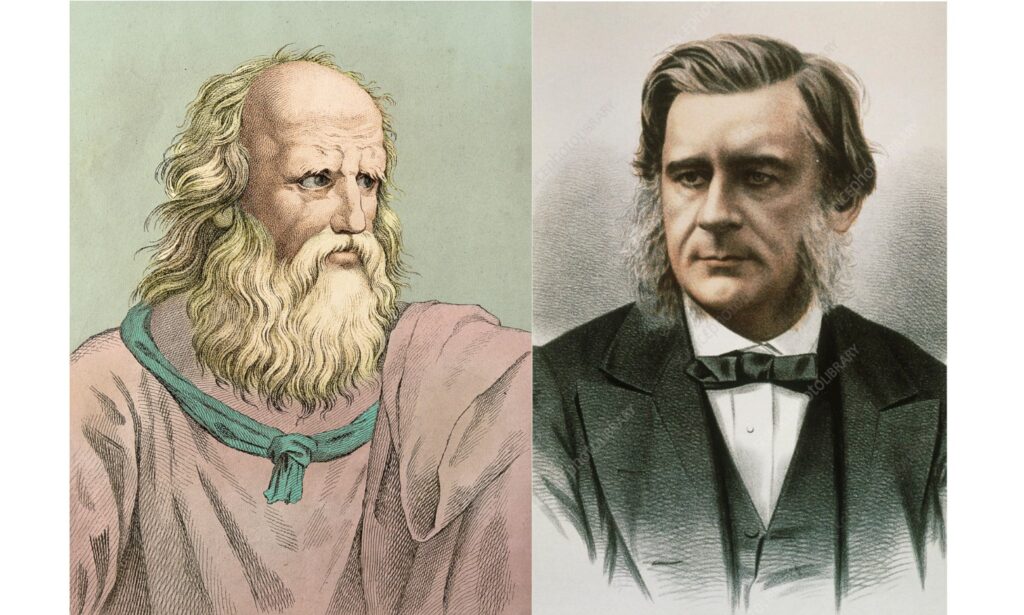
Plato and Thomas Henry Huxley
Professor Lutoloski has said:
I cannot give up my conviction of a previous existence on earth before my birth, and I have the certainty to be born again after my death, until I have assimilated all human experiences, having been many times male and female, wealthy and poor, free and enslaved, generally having experienced all conditions of human existence.
But such transmigration theories of the empiricists of the west or those of the western philosophers of the seventeenth and eighteenth centuries like Franciscus Mercurius Helmont, Leichtenburg, Lessing, Herder, Schopenhauer, etc. or of Jalaluddin Rumi of the Sufi sect of Persia, or of the Theosophists, or of the Indian Nyaya philosophy under the aphorism:
From the desire for the mother’s breast milk due to the habit of the previous life.
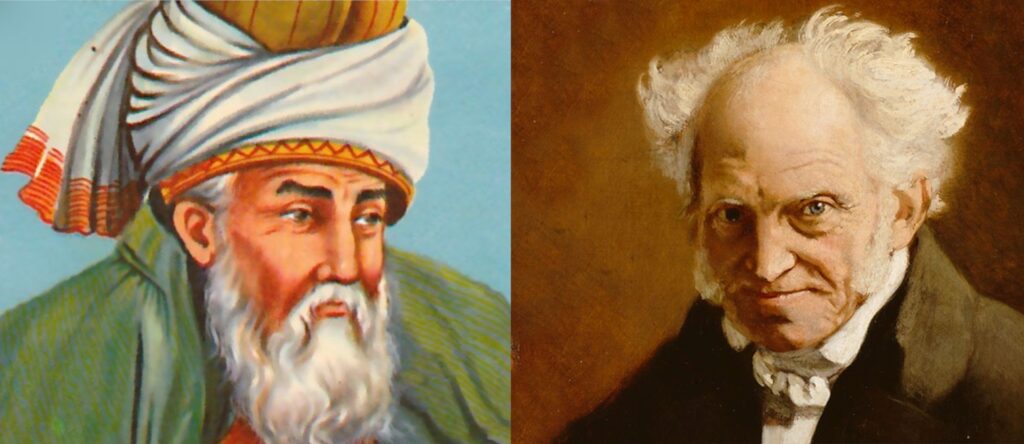
Rumi and Arthur Schopenhauer
Or of the Buddhistic doctrine of annihilation in matter – these are assailable by various hostile reasonings and having their origin in inductive [speculative] concepts, are incomplete and imperfect. But the conclusion in this respect of the Srimad Bhagavatam is fully flawless and significant. The Vaisnava philosophy having shown the royal road to the acquirement of the highest blessedness even in the present life, there is no need of waiting for future lives. As such, the Vaisnava philosophy is thoroughly aloof from all wrangling full of useless riddles over the doctrine of transmigration.

Vyasadeva: the literary incarnation of God and author of the Vedic scriptures
Professor Suthers was obviously greatly impressed with the wonderful teachings of Bhaktisiddhanta Sarasvati on reincarnation and many other subjects, and had many misconceptions he held about Indian beliefs cleared up with irrefutable logic and scholarship. These answers highlight the Thakur’s incredible ability to perfectly quote various scriptures and philosophers in off-the-cuff answers to his various questions. The professor commented:
Professor Suthers: I am able to feel the super-excellence of the Vaisnava philosophy among the Indian Philosophies. … I have truly been astonished to hear from your Holiness these mysteries of the Vaisnava philosophy and their scientific analysis with the most reasonable arguments. I could not even think before that there are in the Vaisnava philosophy such excellent solution, corroboration and elucidation of the problems of Indian philosophy.
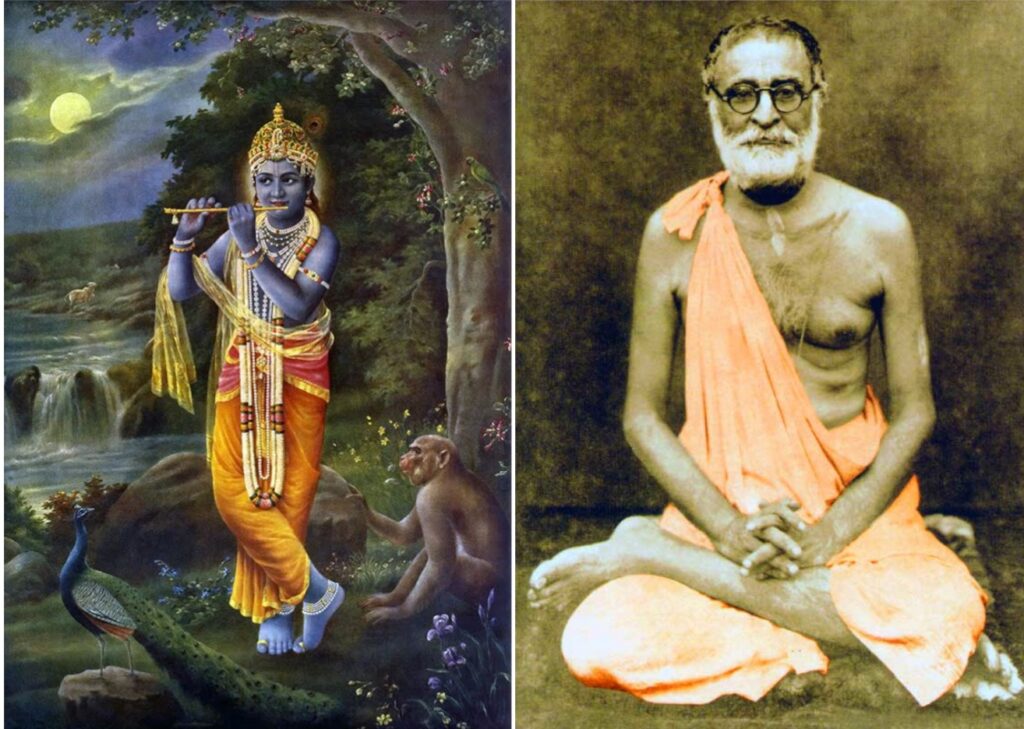
In this world of Maya, which is averse to the Lord, full of trials and tribulations, only patience, humility and respect for others are our friends for Hari bhajana.
[Srila Bhaktisiddhanta Sarasvati]
[Modified extracts from Ray of Vishnu by Rupa Vilasa Das]


Comment
Namaste Thank you Keneram das. We readers eagerly await the next installment. Jaya Haribol